Private Cloud
About
Private Cloud enables users to provision non-Mac Virtual Machines (VMs) using reserved compute and storage resources. (Reserved compute and storage resources are a cost-optimization feature that allows users to reserve a specific amount of capacity for a cloud service at a lower price.) Non-Mac VMs are essential in enabling certain parts of scalable build systems on Mac, such as caching servers.
MacStadium Private Cloud is built on multi-tenant shared cloud infrastructure. Users can to pay for fixed amounts of isolated compute/storage/networking resources and deploy any combination of virtual machines with their desired configuration. Private Cloud also has network access to Mac infrastructure, allowing the use of non-Mac virtual machines in tandem with Mac compute resources.
Overview
With Private Cloud, users can purchase an allocation of Virtual CPU, Virtual RAM, and Storage and manage the deployment of those resources using Private Cloud’s dashboard.

MacStadium Verge Home Page
NOTE:
The Machines Dashboard displays the statistics for the VMs in a cluster. It also displays storage usage as well as machines that are not in use.
Getting Started
While there are many ways to get started using Private Cloud, based on needs of your company or the number of VMs running, many users follow these steps.
Step 1. Create a New VM using a recipe.
Step 2. Upload images to the VM.
Step 3. Import a VM from a media image.
Step 4. Review resource management.
Step 5. Create a Snapshot.
Creating a New VM with a Recipe (recommended)
Users can create a new VM using a predefined recipe. Recipes are VM image templates that allow the automated creation of a new preconfigured VM with the selected operating system, applications, and configuration information. Recipes are quick and convenient, and may be preloaded with various software configurations.
To enable configuration, recipes include questions about each instance, such as the desired network configuration, username and password, in addition to standard VM parameters such as drive size or amount of RAM.
NOTE:
MacStadium recommends using a recipe when deploying a new VM, especially for users new to this process. Recipes ensure that VMs are configured optimally for operation within Private Cloud, and are much faster to install and deploy when compared to manual VM creation.
- Select Machines Dashboard → Virtual Machines.
- Click New VM.
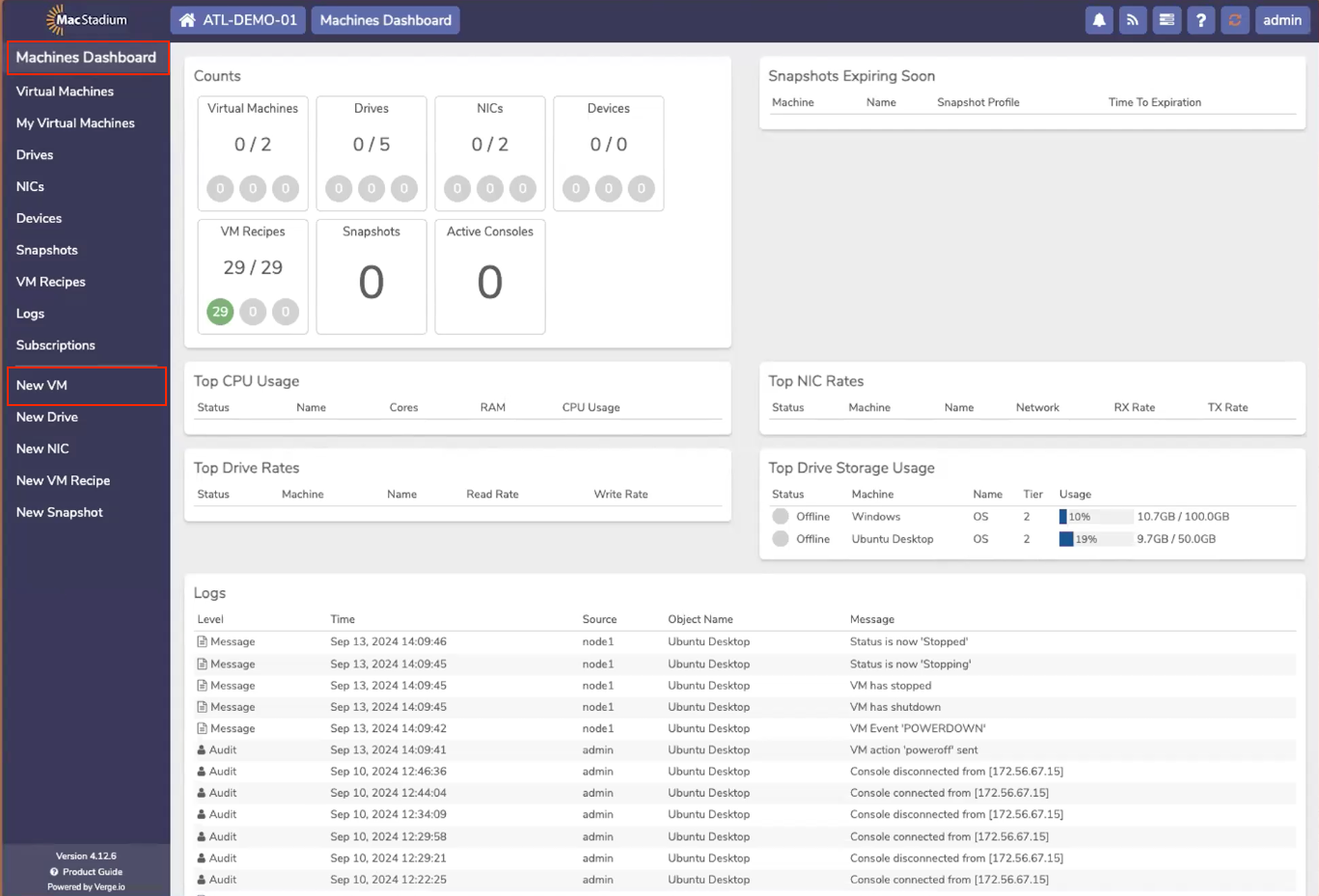
New VM
- The Select Type tab opens. The left-hand side of the screen contains a list of options (Operating Systems, Services, and so on.) The right-hand side of the screen contains a list of recipes.
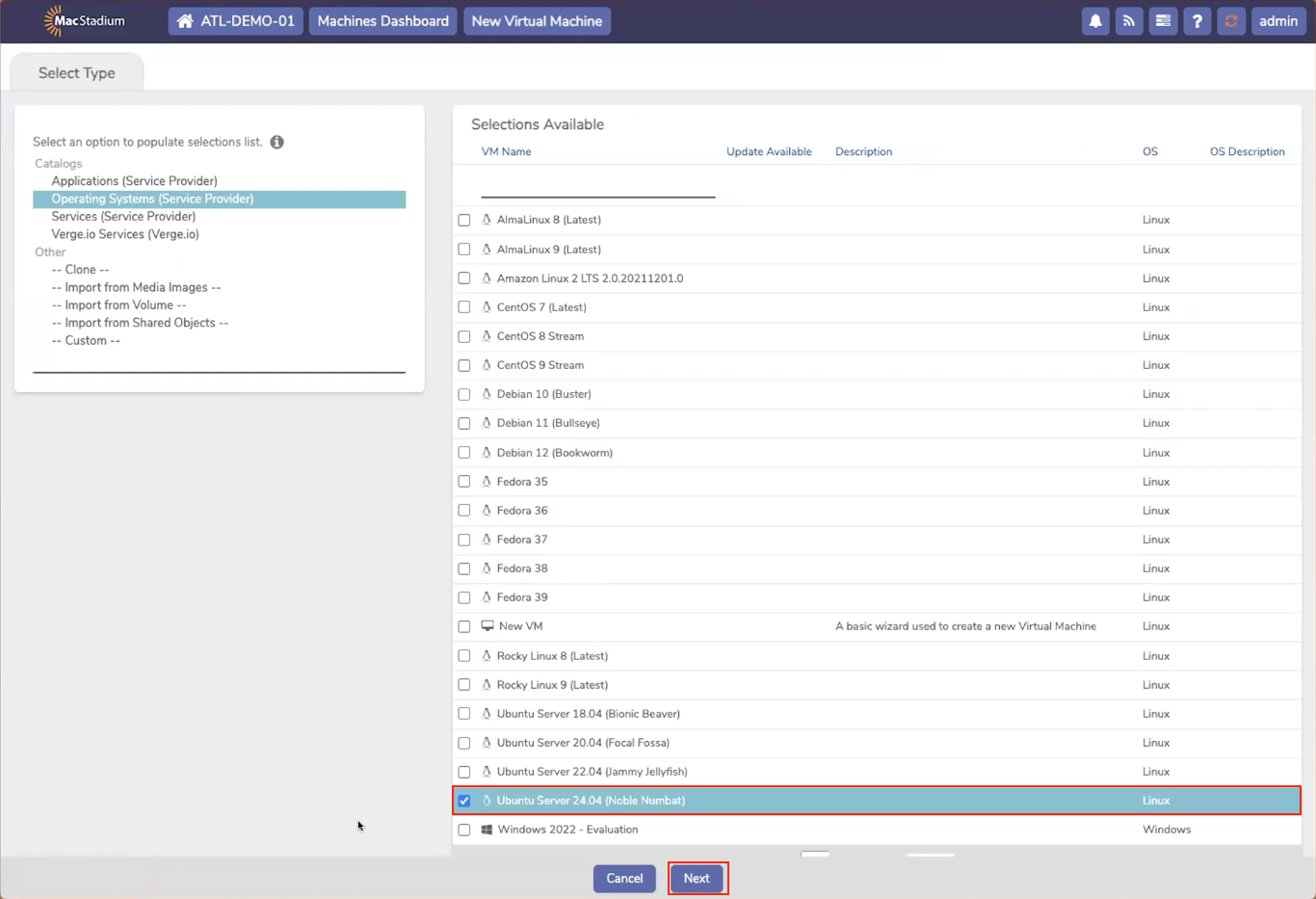
Existing Recipe Recommended (Ubuntu Server, example)
NOTE:
MacStadium recommends using a preexisting recipe if a recipe exists for the OS required. Recipes always install the latest version of the selected OS in an optimal configuration with minimal post-installation configuration required.
If there is not an OS recipe that the user needs, then select New VM and use the template to create a new recipe for that OS.
- In the example, the user selected the recipe for Ubuntu Server 24.04; click Next.
- The Virtual Machine Setting tab opens.
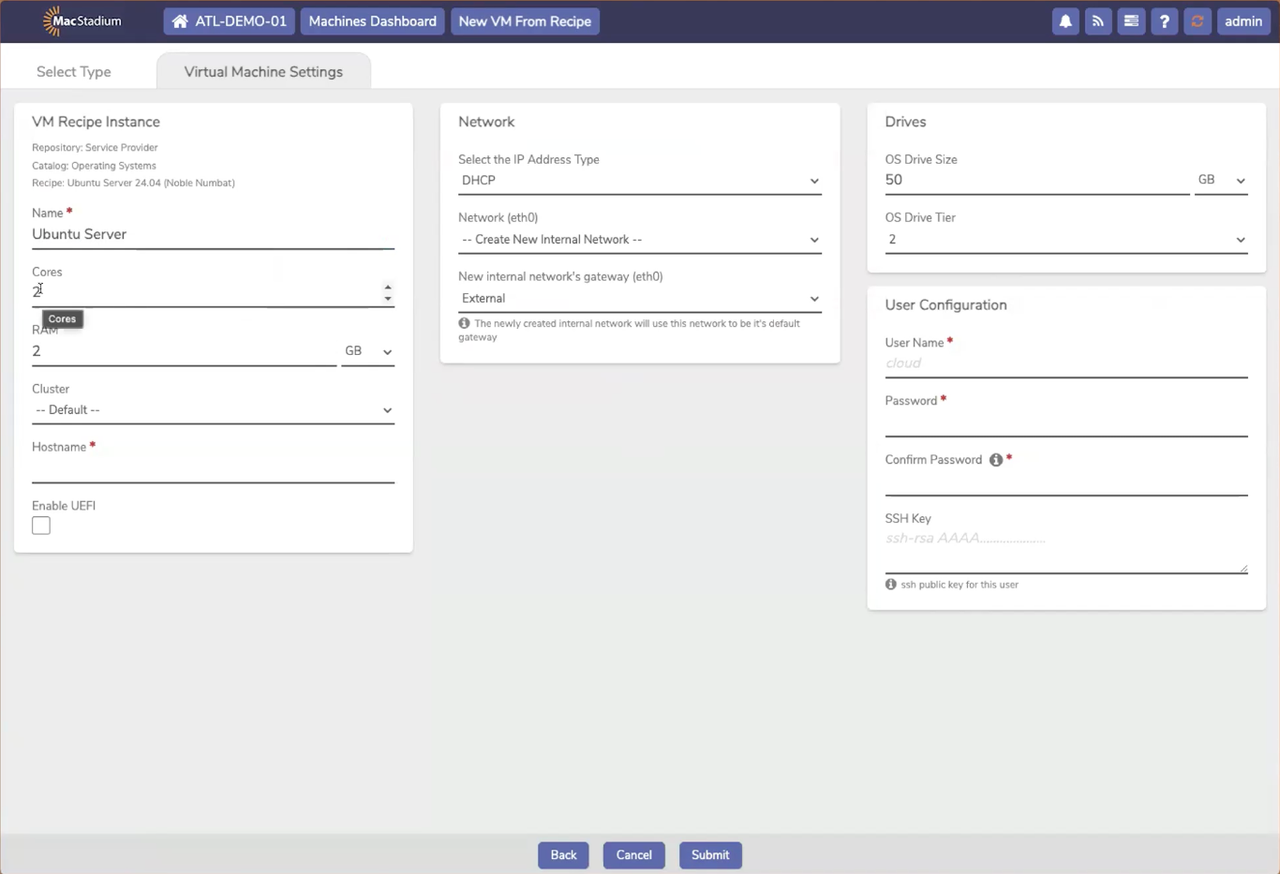
Virtual Machine Settings tab
- In the VM Recipe Instance box, complete the following fields:
- Name - the machine name used for management inside Private Cloud
- Cores - specifies the number of vCPUs allocated to this machine
- RAM - specifies the amount of RAM allocated to this machine
- Cluster - specifies the compute cluster to deploy the machine to. This should be left as Default.
- Hostname - the network hostname for the machine
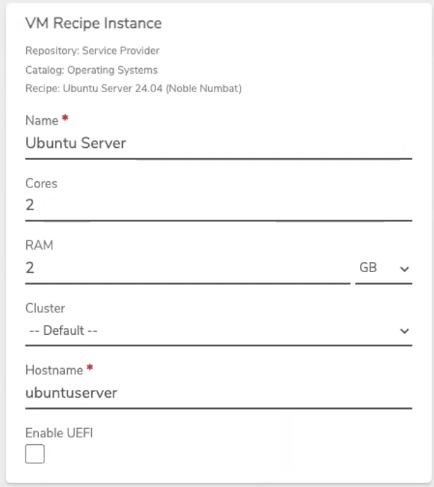
VM Recipe Instance
- In the Network box, users must select Static from the dropdown box. Users must also select the correct Network from the dropdown list in order to ensure connectivity to existing MacStadium infrastructure. Otherwise, Private Cloud will provision a new isolated network for the VM.
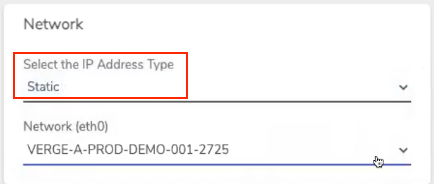
Network
WARNING:
Do not use DHCP as the IP Address Type when connecting VMs to existing networks. While DHCP is the default setting for IP Address Type, MacStadium Mac infrastructure is deployed with static IPs, and no DHCP server is present. In order for network connectivity to work for deployed VMs on MacStadium networks, an IP must be set manually using the Static IP Address Type.
- In the Static IP Configuration box, all fields must be completed. However, the auto option in the IP Address field does not work. Complete the following fields:
- IP Address – Specifies the IP address of the server. The default is auto, this is an invalid option for the static IP. Consult the IP Plan in your MacStadium Portal account to determine an IP Address that doesn’t conflict with existing machines.
- Subnet Mask – Specifies the range used for the subnet. This is in CIDR notation. The most common selection is ‘/24’
- Default Gateway – Specifies the IP to use for routed external traffic. This should be listed in the IP Plan
- Nameservers – Specifies the DNS servers to use for name resolution. This is not optional, and must be completed in order to resolve hostnames.
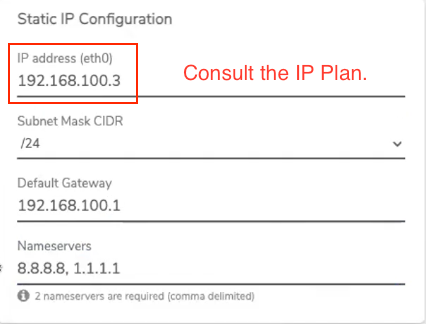
Static IP Configuration
WARNING:
The default IP Address is Auto, however, this option does not work. Users must select an IP Address that is not currently being used by their machine, in the subnet of the network they are connected to. Please consult the MacStadium IP Plan.
For the private subnet, users can have on reserver, addresses near the end of the subnet. A subnet of 10.254.232.0/24, for example, can reserve address range, 10.254.232.200 through 10.254.232.250 for VMs.
This only works for customers who will not use the entire subnet for bare metal hosts. In the Drives box, select the OS Drive Size and OS Drive Tier. The OS Drive Tier specifies the tier of storage to deploy to, currently, only Tier 2 is available.
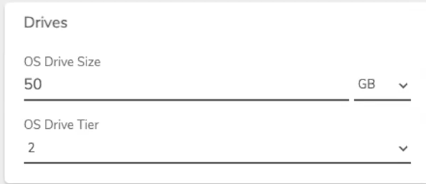
Drives
- In the User Configuration box, complete the following fields:
- User Name – the desired username for the default user on the server
- Password – the desired password for the default user on the server
- Confirm Password
Or
- Provide an SSH Key – optional, enables SSH key authentication for the default user
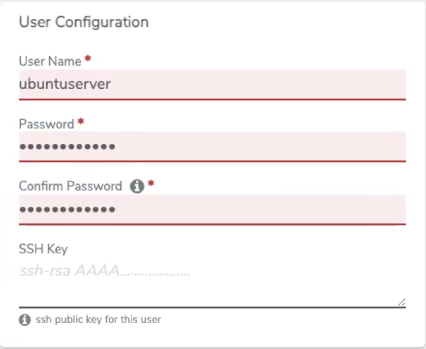
User Configuration
- Click Submit.

Submit
- The new VM screen (Ubuntu Server, in this case) opens and the drives will begin to initialize. This may take a few minutes to complete, as Private Cloud will fetch the latest disk image for the selected operating system if an update is available. During this time, the Drive status will be listed as Importing.
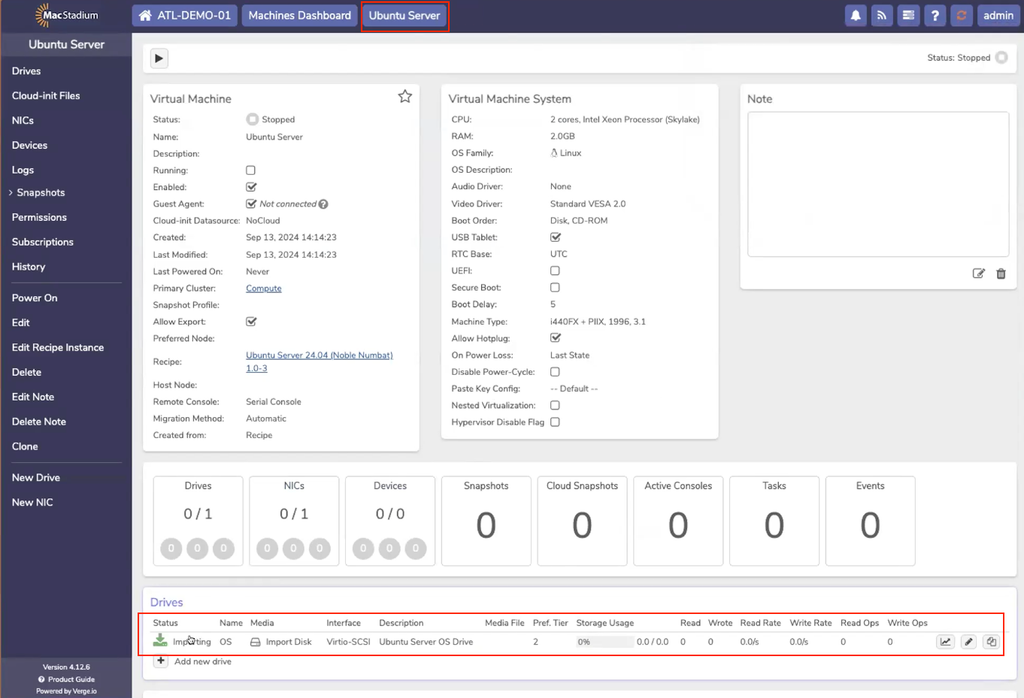
New VM Screen
- Once the drive has finished importing, the status will change to Offline. At this point, the machine is initialized and ready to be powered on.

Offline = Ready to Launch
- Click the Power button and the Confirmation box opens. Click Power On.
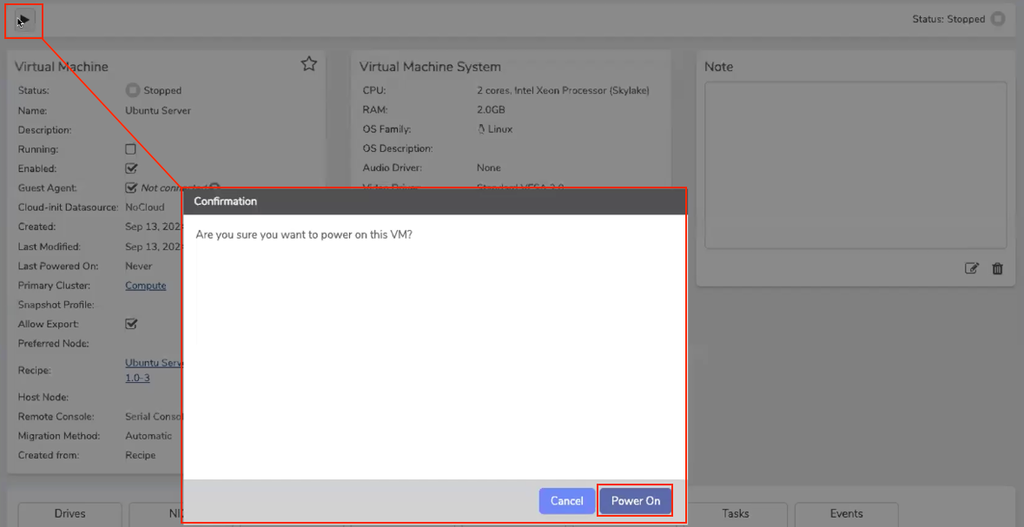
Power On
- Open the Console by clicking the Console button.

Console Button
- When the Console opens, the disk boots and stops at a login prompt. Shortly after, the machine will start to download the latest available software updates.
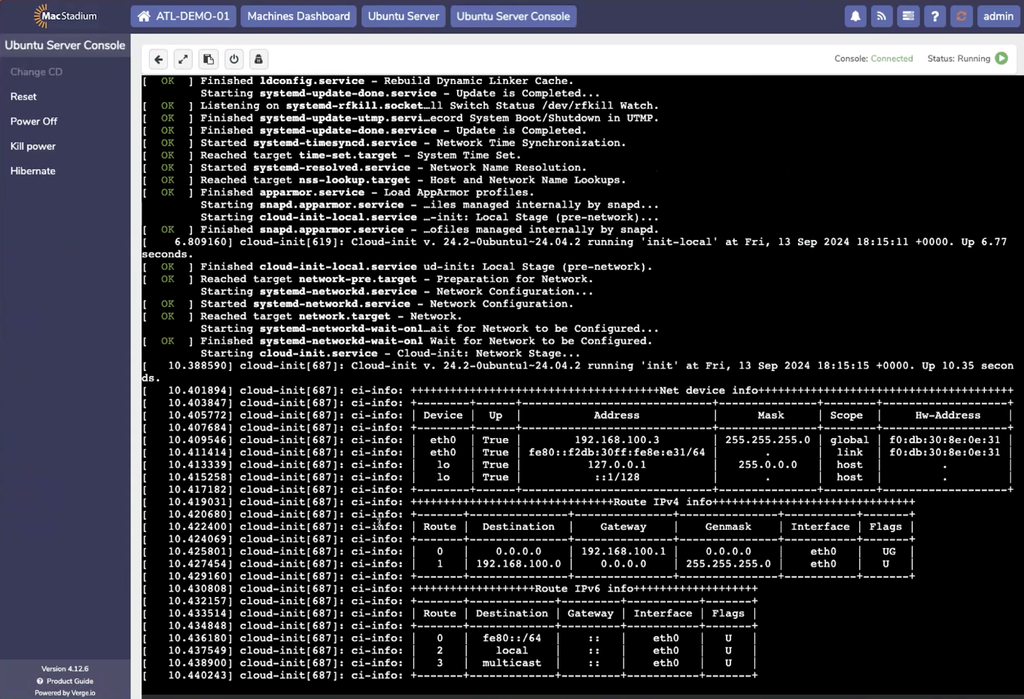
Console
NOTE:
For the majority of Linux virtual machine recipes, the Console is configured to appear as a text terminal. This makes copy/pasting text much easier, and enables easy access to terminal history.
Windows Installation
NOTE:
Installing Windows 2022 from a recipe is easy and downloads the correct ISO, which starts with the right drivers. MacStadium recommends using a recipe to install Windows 2022.
To install Windows without a recipe, follow the steps in the Windows Installation Workaround sections.
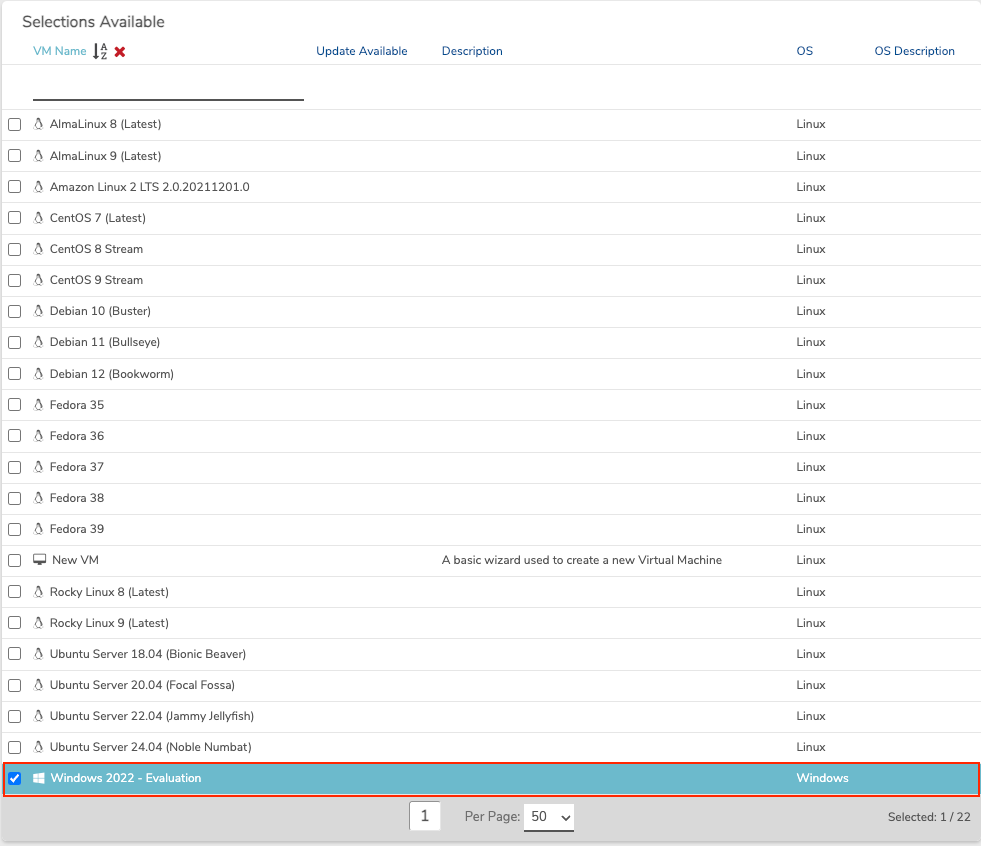
Windows 2022
Creating a New VM Manually
In addition to deploying VMs using recipes, virtual machines may also be created manually. This is primarily done when specific versions of OSes are required (for instance, desktop versions of Windows). Manually deployed VMs take additional effort to configure when compared to deployments from recipe. MacStadium recommends the use of recipes for VM deployment whenever possible.
Uploading Images
For manually created VMs, guest operating system are installed by adding a CD-ROM device with media file set to a bootable install ISO. Install ISOs are stored in the Media Images repository.
To upload an ISO for installation:
- Select Machines → Media Images.
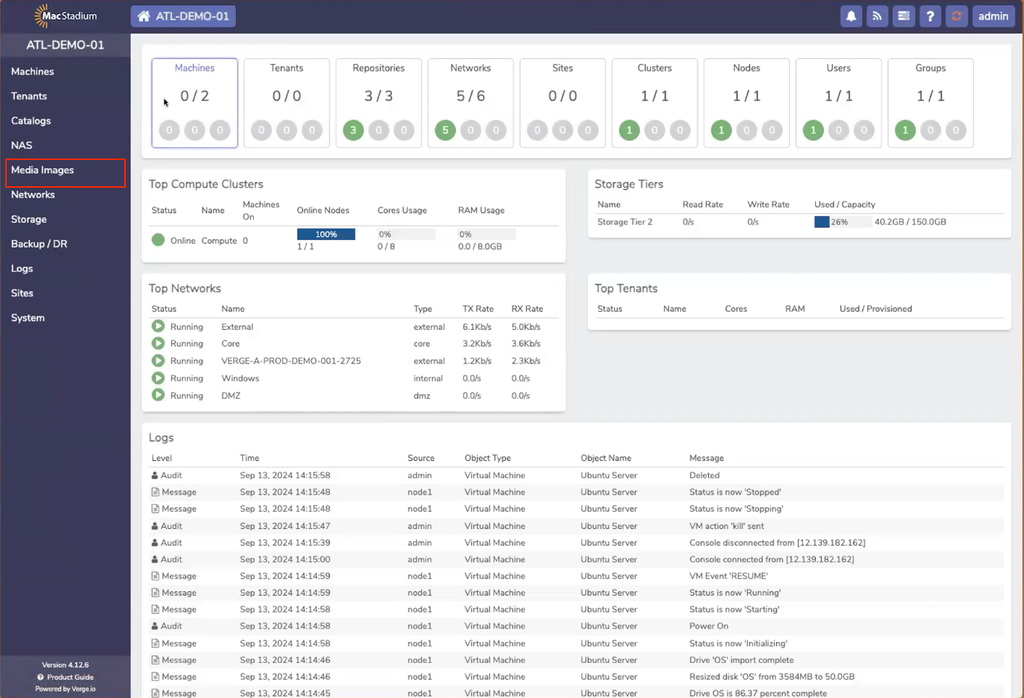
Media Images
- The Media Images page shows stored install disk and uploaded VM images. There are two ways to upload images for install:
- Upload from URL - Private Cloud downloads the image from a remote URL
- Upload - The image is uploaded from the connected desktop
NOTE:
In this example, we will use Ubuntu Server as the install image.
Upload from URL
NOTE;
Upload from URL is the recommended approach, as Private Cloud can often download images faster directly from the repository.
- Find a direct link for the install media for the desired OS. In this case, Ubuntu only offers direct links through their mirror, so we’ll select Alternative downloads, and get the URL from a mirror.
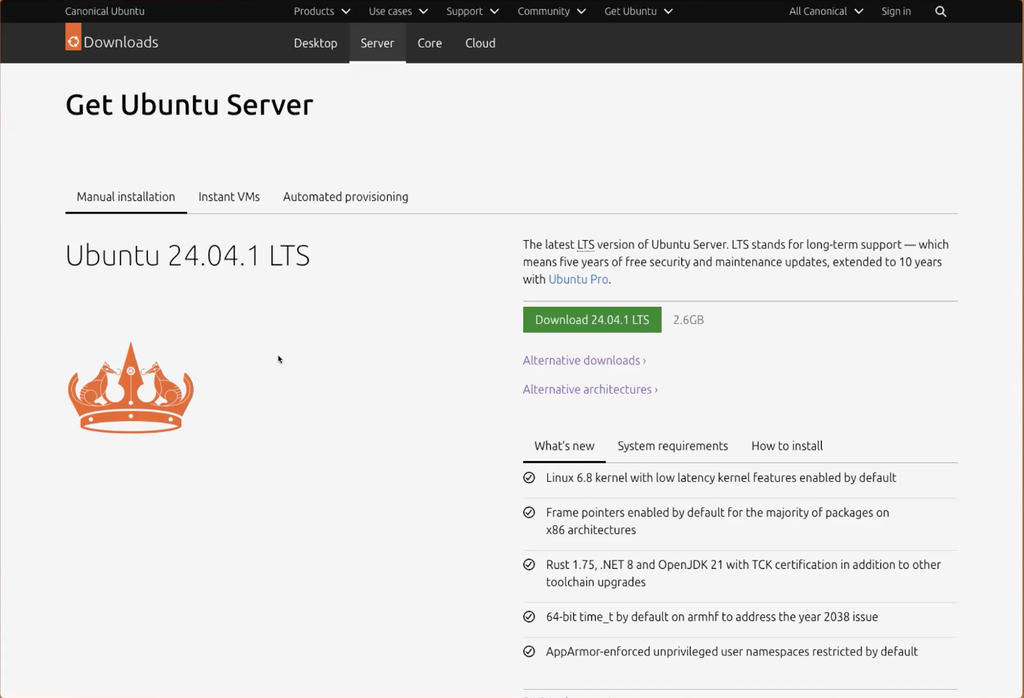
EXAMPLE: Ubuntun Server Download
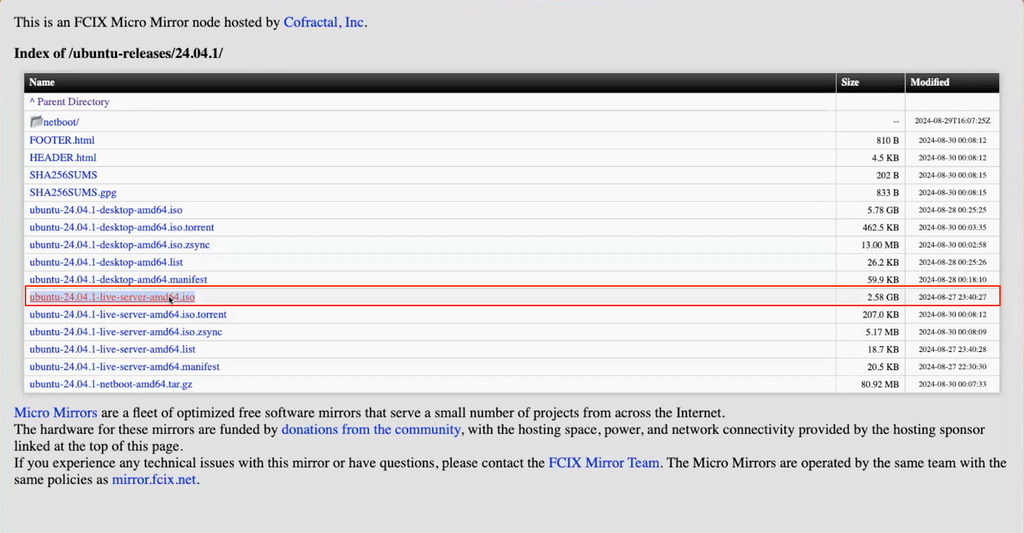
Direct Download links from Mirror
- Next, we will upload the image to Private Cloud from the mirror. Return to the Media Images pages. Select Upload from URL.

Upload from URL
- The Upload from URL dialog box opens.
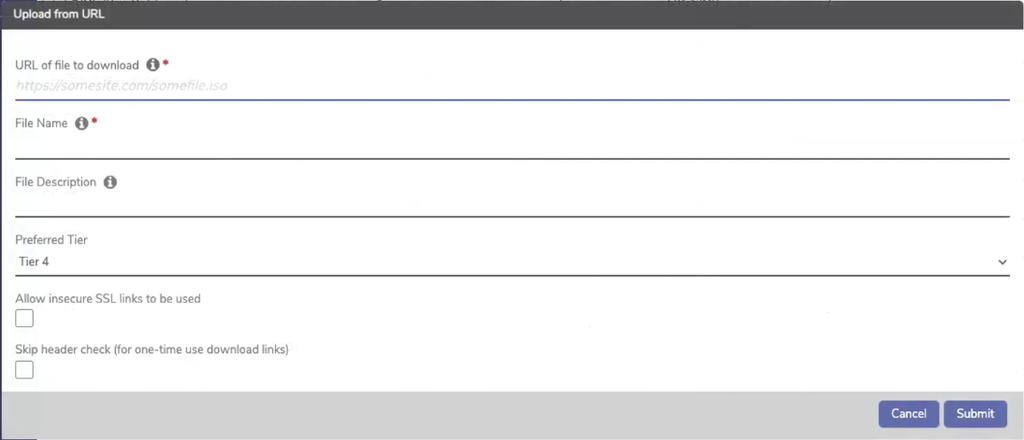
Upload from URL
- Paste the download link into the Upload from URL page.
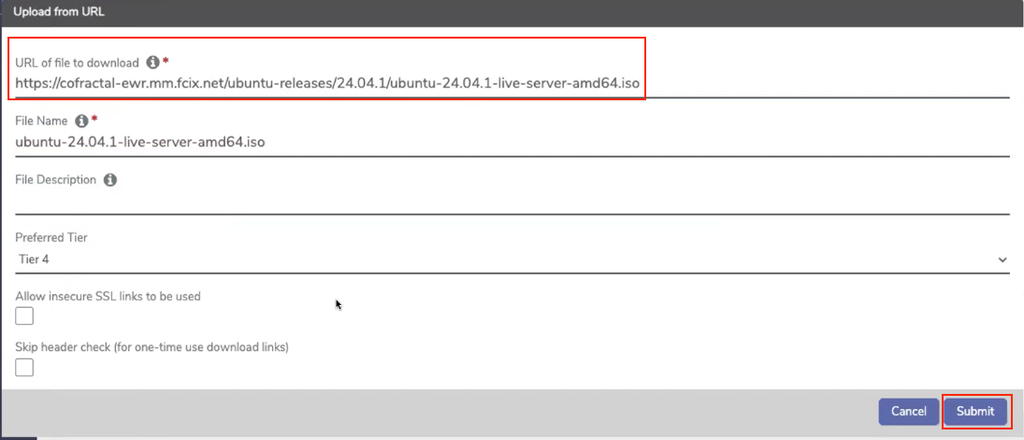
Copy Link
- Click Submit, and the Upload Process begins.

Upload Process
Upload Directly
- To upload an ISO from the connected computer, choose Upload on the Media Images screen. The Upload Files screen appears.
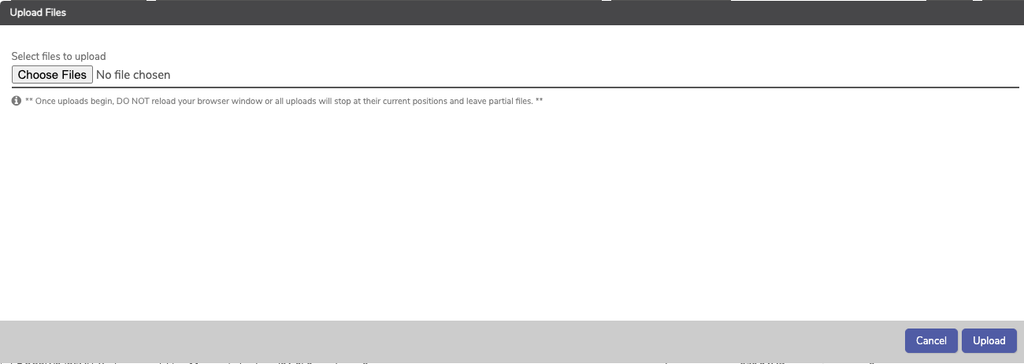
Upload Files Screen
- Click Upload, and the Upload Process begins.
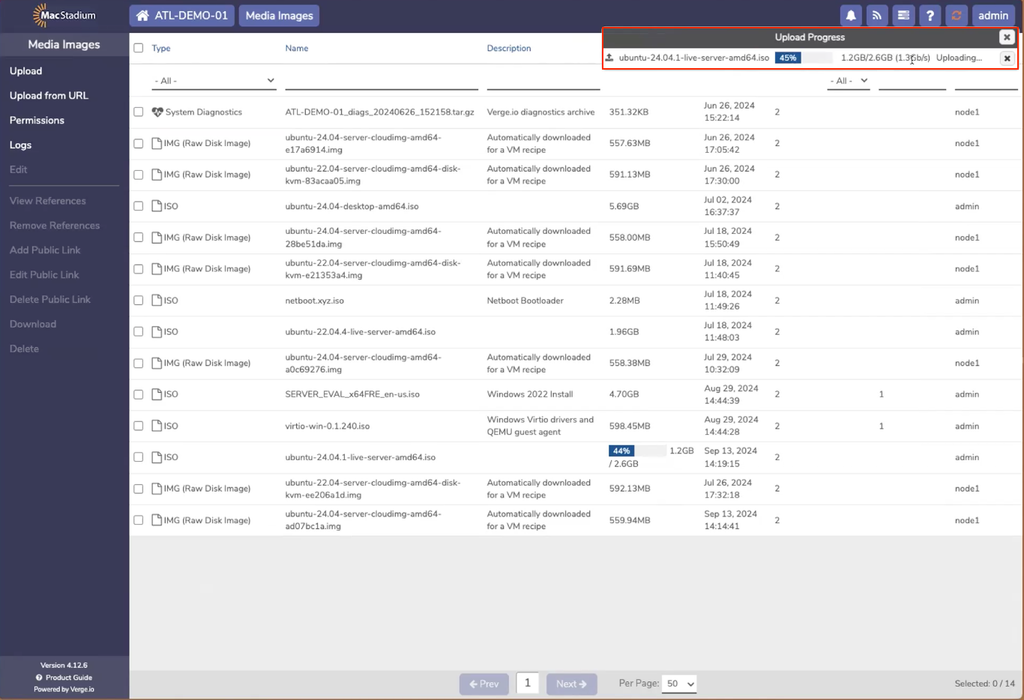
Upload Process
VM Creation and OS Installation
- Once the file completes the download process and the files appear in the Media Images page, Navigate to the Machines Dashboard.
- Click New VM.
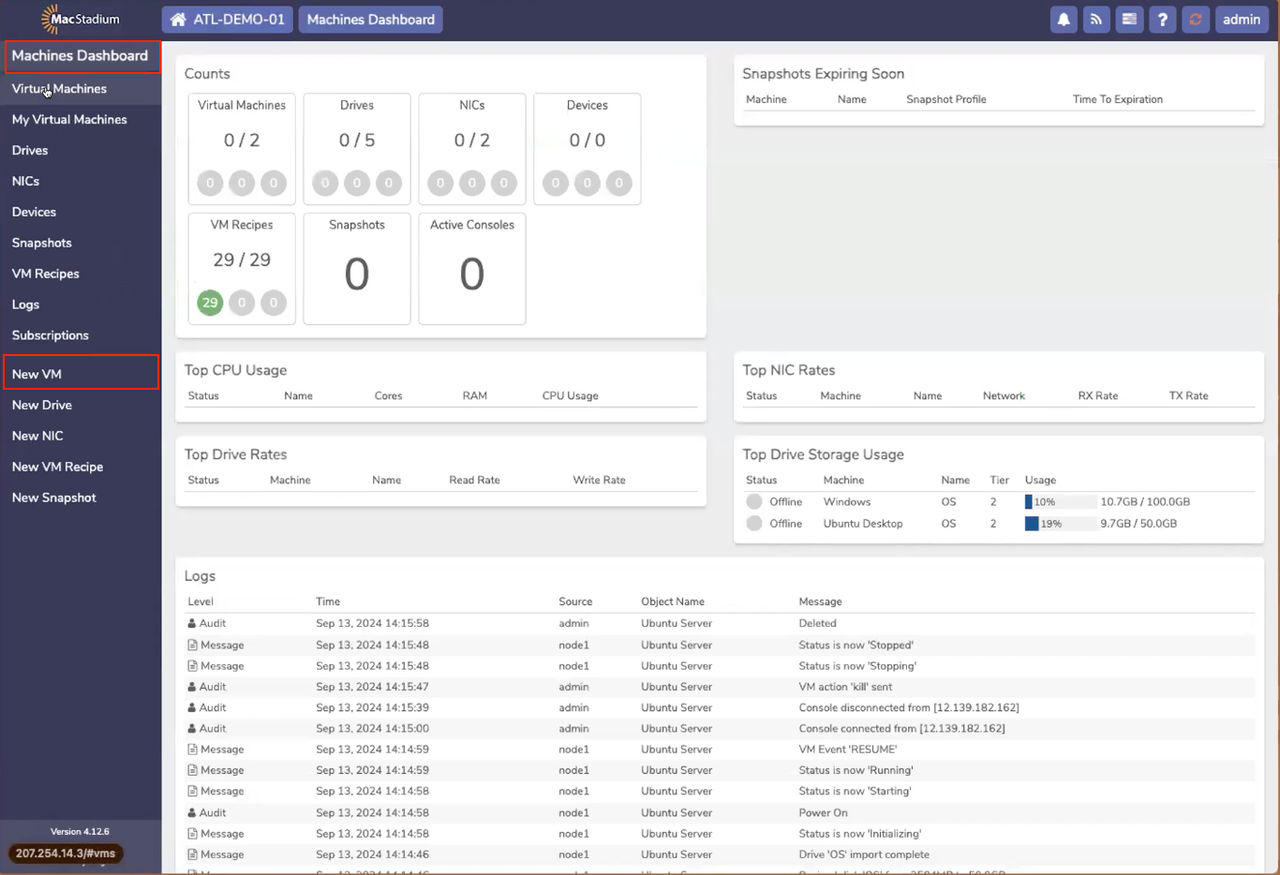
New VM
- On the Select Type tab, select New VM and click Next.
NOTE:
New VM is a blank recipe that allows for manual OS installation.
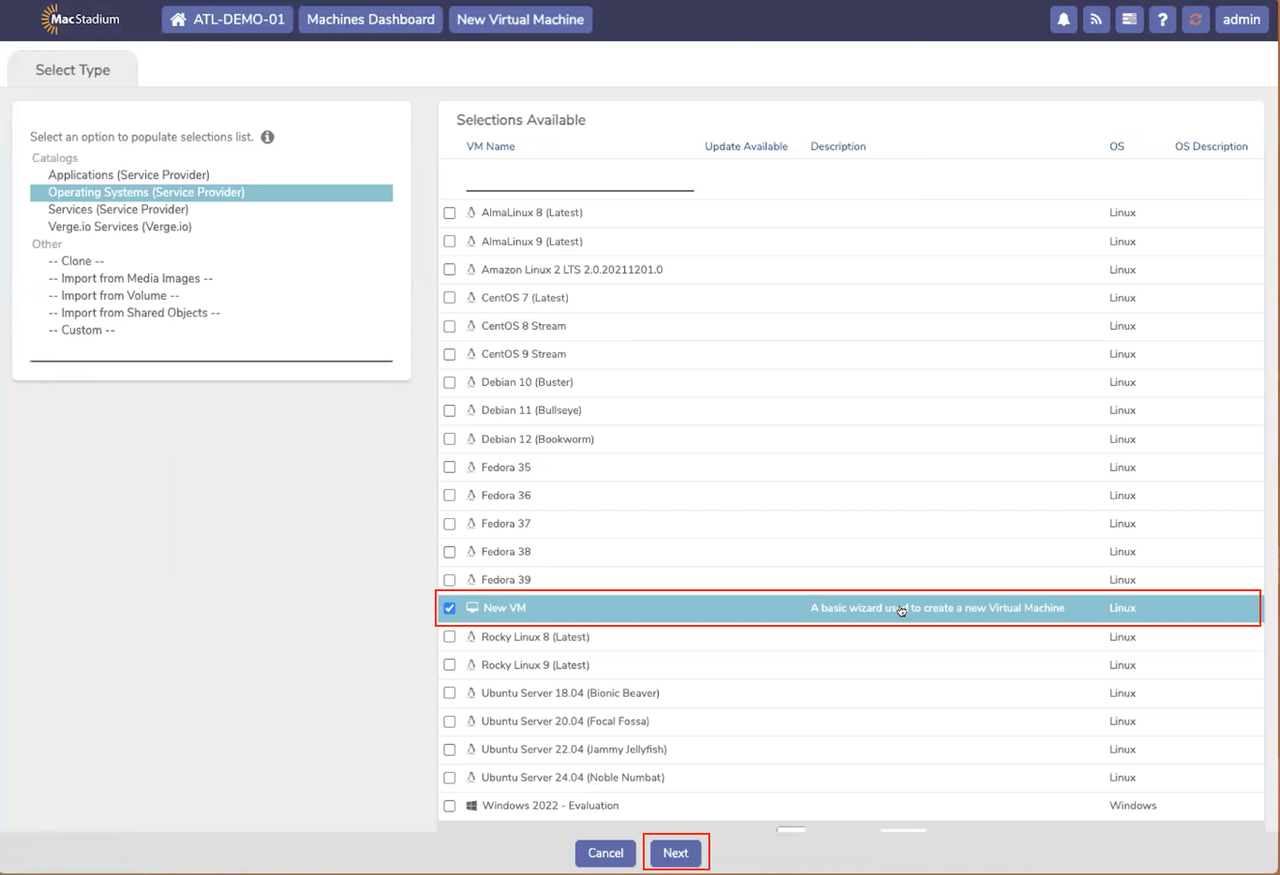
Select Type Tab
- The Virtual Machine Settings tab opens.
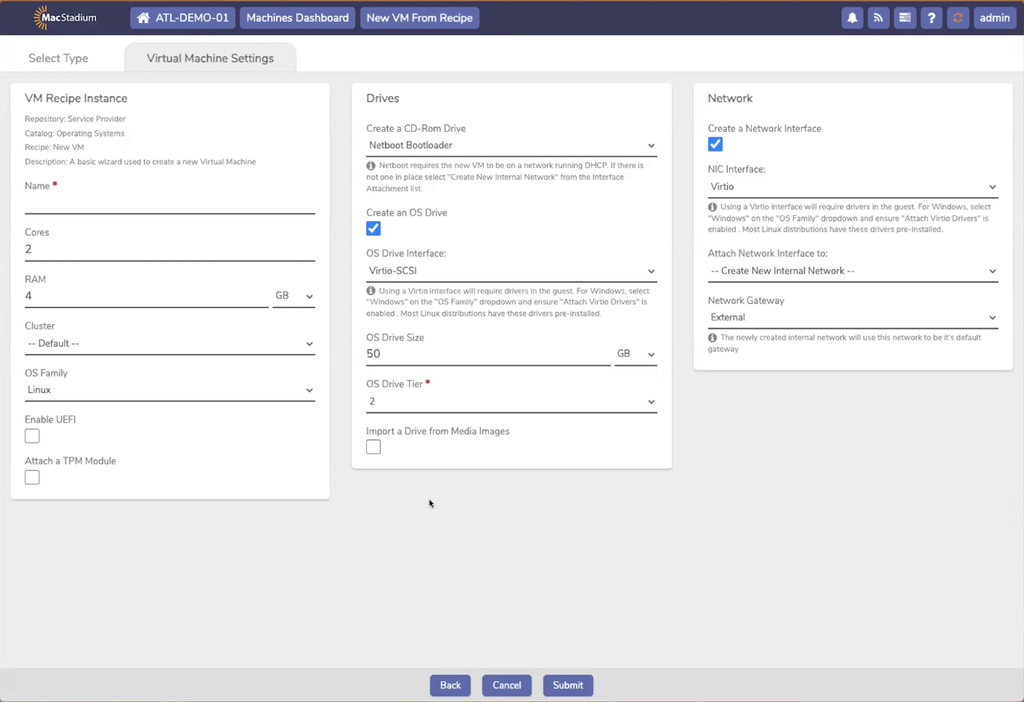
Virtual Machine Settings tab
- In the VM Recipe Instance box, complete the following fields:
- Name
- Cores
- RAM
- Cluster (can be left as Default)
- OS Family
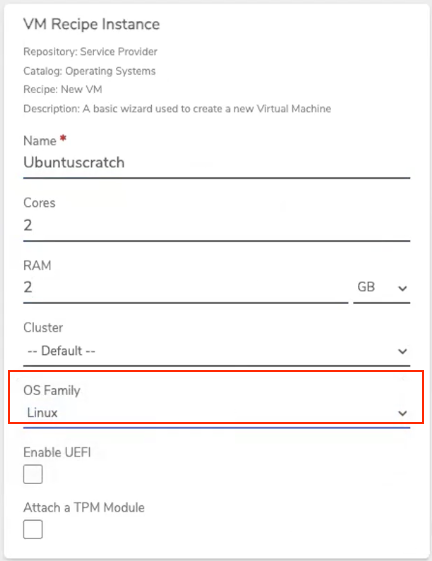
VM Recipe Instance
NOTE:
It is important that the OS Family matches the OS type installed.
- In the Drives box:
- Create a CD-Rom Drive, select Use Local Media Image
- Attach Selected iso to CD-ROM, select the file that was previously uploaded into Media Images
- OS Drive Interface, select Virtio-SCSI
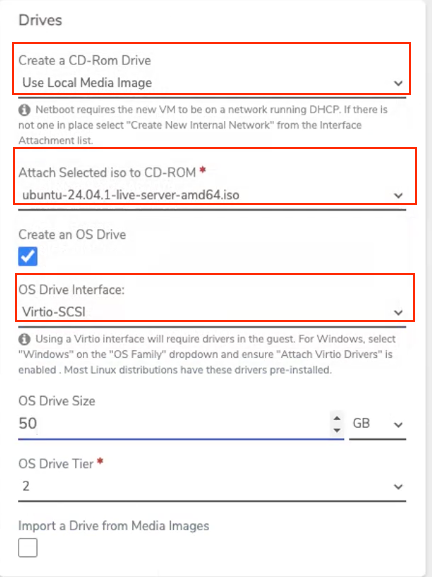
Drives
- In the Network box, make sure the Create Network Interface is checked and select the interface from the dropdown.
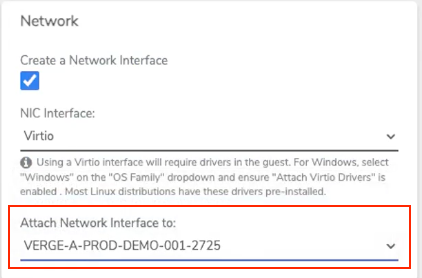
Network
WARNING:
Unlike OS Recipe templates, manually created VMs require that IP configuration be done at the OS level, and cannot be configured when deploying the VM.
- Click Submit.
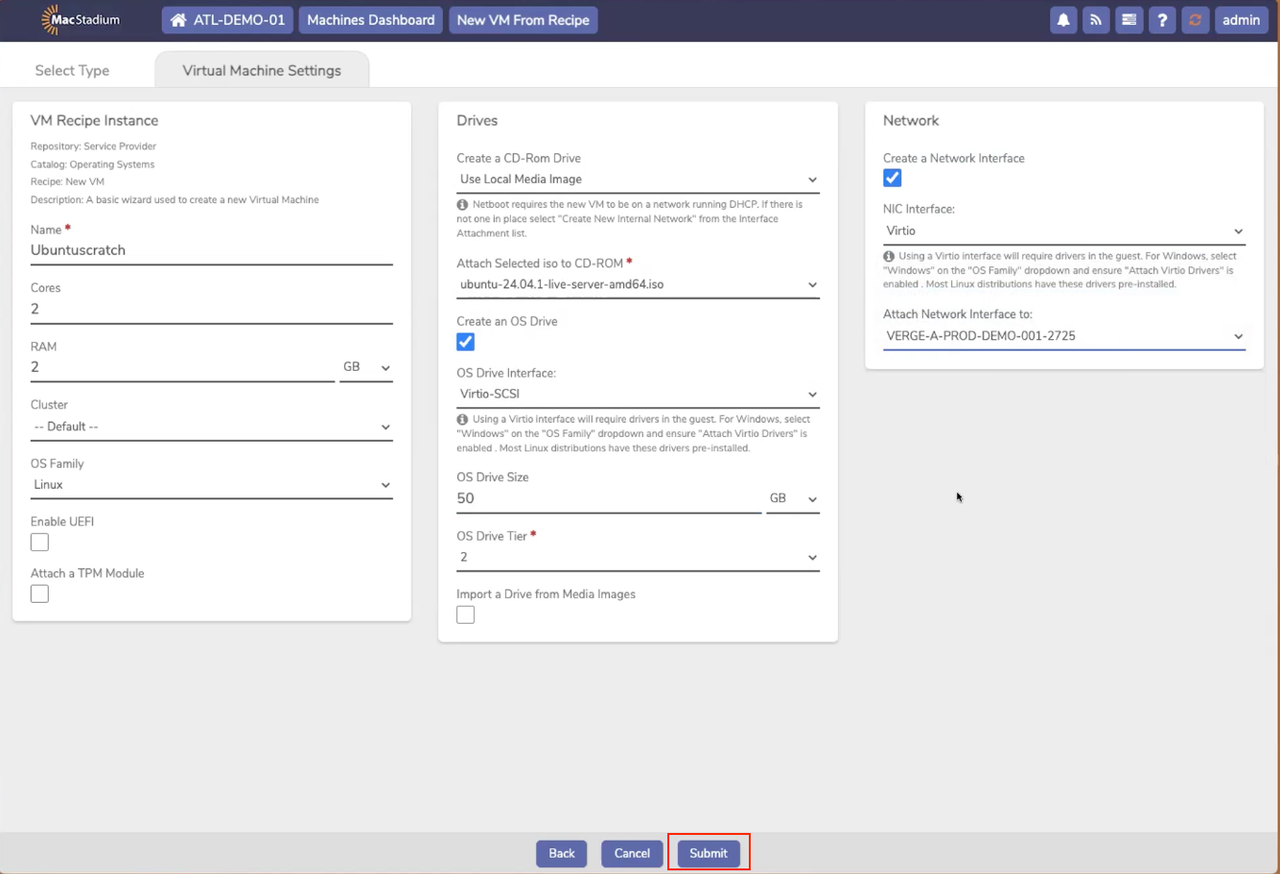
Sumbit
- The new VM screen opens. Click the Power button and the Confirmation box opens.
- Click Power On.
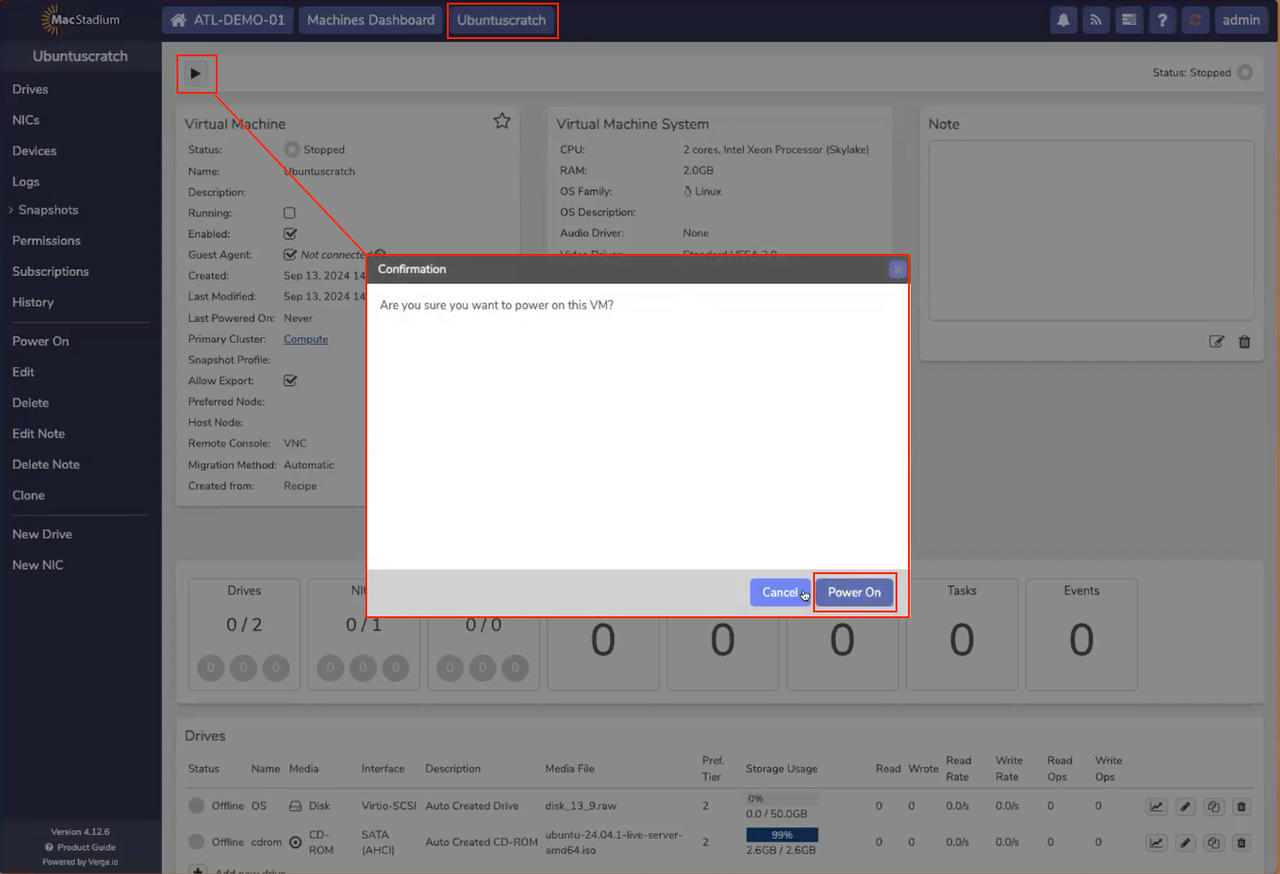
Power On
- Next, the OS must be installed and configured. To access the machine, click Console.

Console Button
- The Console opens.

Console
NOTE:
Manually deployed VMs use a virtual screen, rather than a virtual terminal, meaning that text cannot be copied from the terminal.
- Use the console to install the OS as usual.
- The IP address configuration must be set manually as a part of installation. The process for this can differ, depending on the OS installed. In this example, we are setting a manual IP address for Ubuntu Server 24.04:
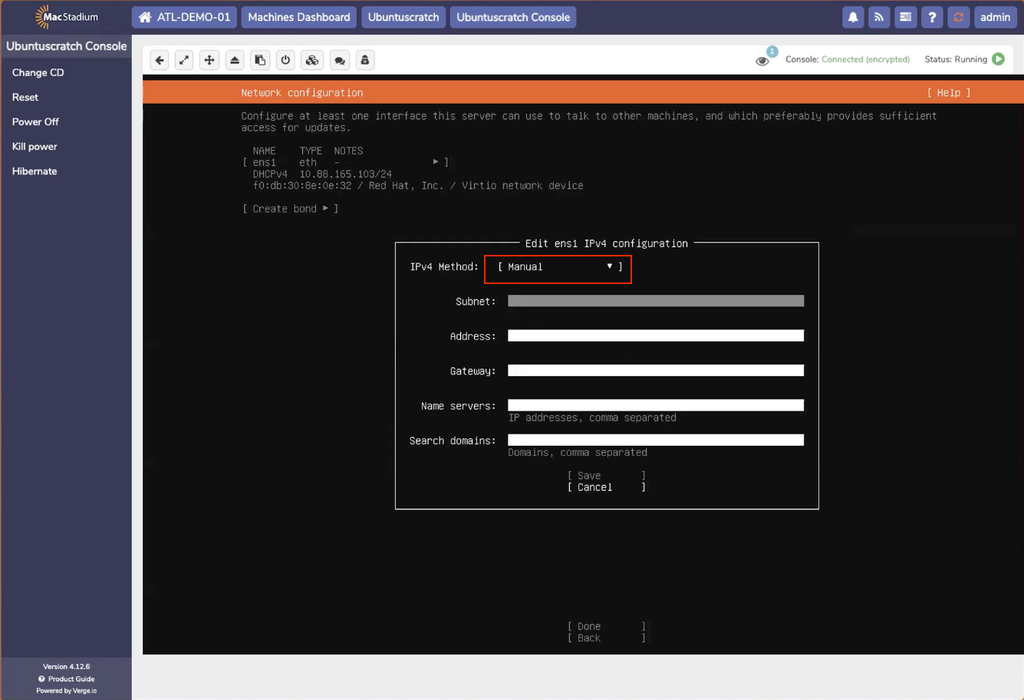
Manual IP Address Assignment
IMPORTANT
DHCP is not supported. An IP address must be manually assigned, using a free IP address on the IP plan. All fields must be completed to ensure network connectivity.
- Complete the installation as usual. Most Linux distributions include drivers for Virtio, which is required for optimal performance when virtualizing hardware.
Manual Windows Installation
IMPORTANT
Windows does not include Virtio drivers by default. These drivers need to be installed from a mounted disk during Windows installation.
NOTE:
For Windows Server installation, MacStadium highly recommends the use of the Windows Server recipe.
- Windows requires additional drivers in order to access Private Cloud’s virtualized storage and network hardware. To install a Windows VM manually, select Machines Dashboard → Virtual Machines.
- Click New VM.
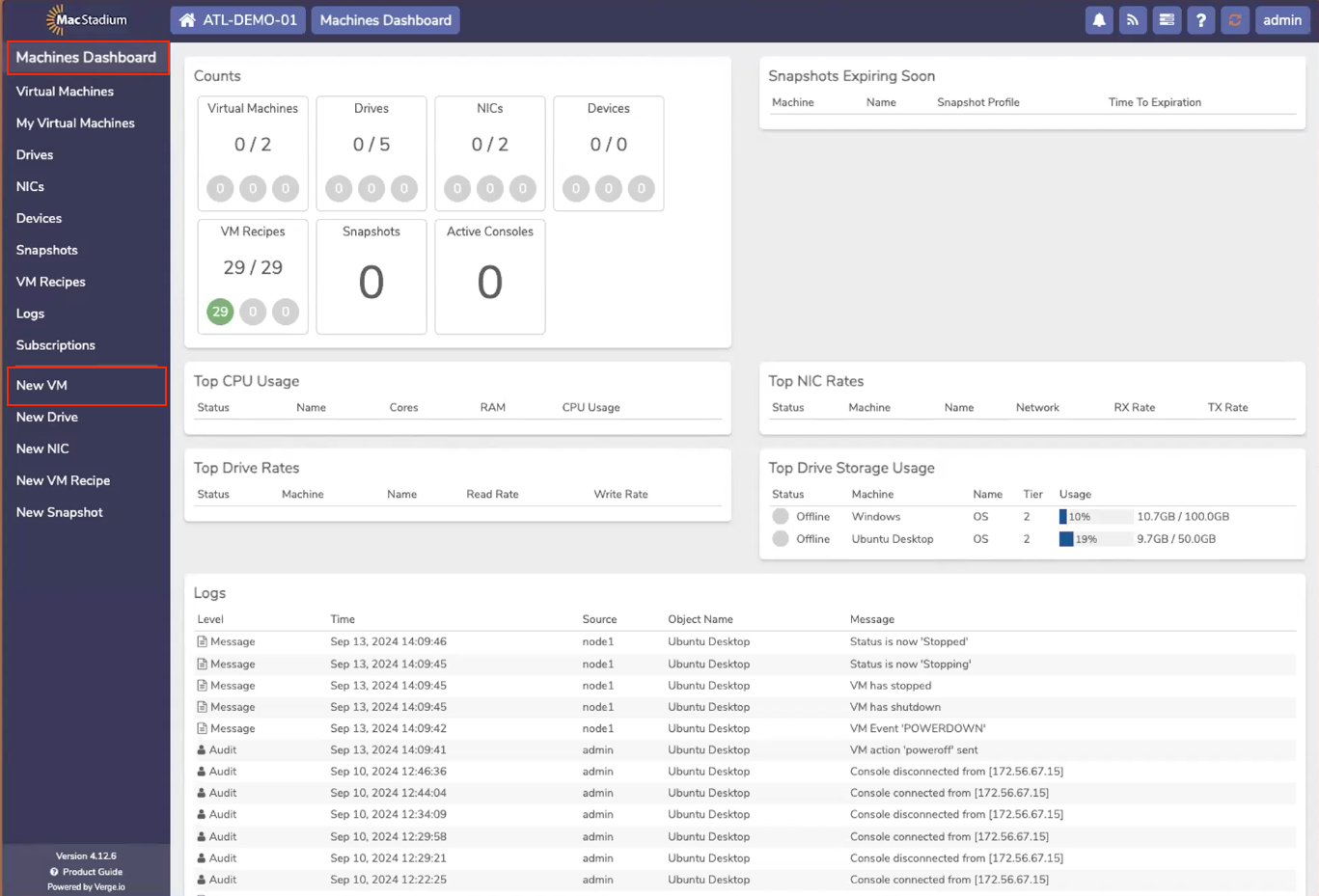
New VM
- The Select Type tab opens. The left-hand side of the screen contains a list of options (Operating Systems, Services, and so on.) The right-hand side of the screen contains a list of recipes. Select New VM and click Next.
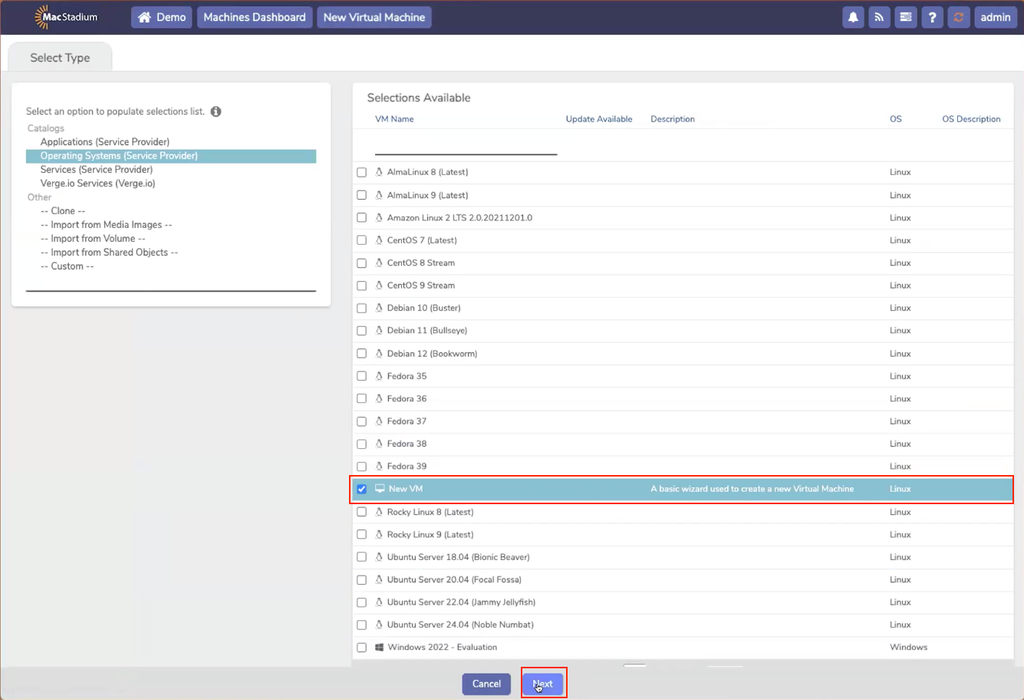
Next
- The Virtual Machine Setting tab opens.

Virtual Settings Tab
- In the VM Recipe Instance box, complete the following fields:
- Name
- Cores
- RAM
- Cluster (can be left as Default)
- OS Family = Windows
- Attach Virtio Drives = checked
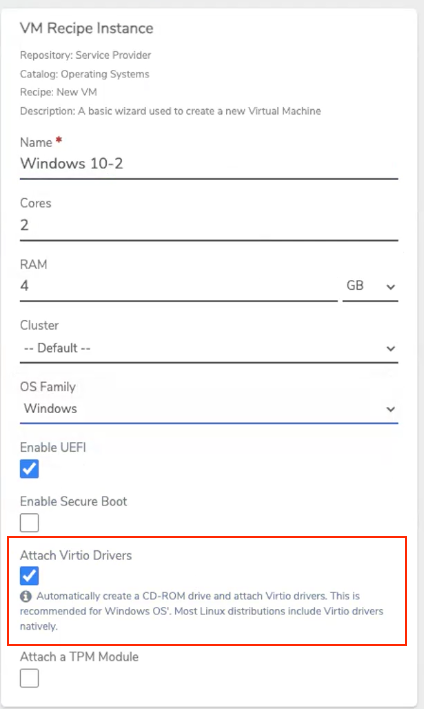
VM Recipe Instance
IMPORTANT
Make sure the Attach Virtio Drivers checkbox is selected. This is required to install the Windows operating system.
Note:
A Windows Install ISO must be uploaded to Media Images before installation.
- In the Drives box, make sure the Create CD-ROM Drive is set to Use Local Media Image. Select an uploaded Windows install ISO.
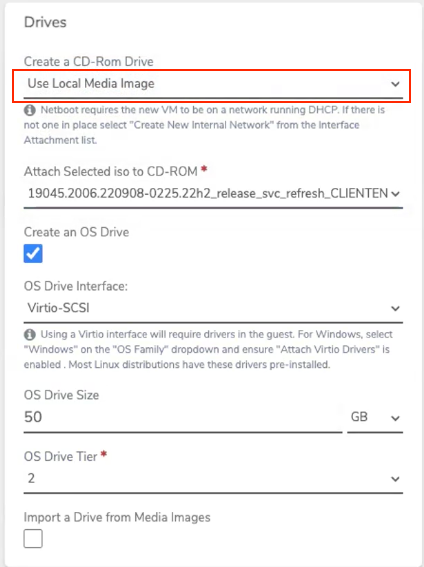
Drives
-
In the Network box, set the NIC Interface to Virtio, and the Attach Network Interface to Internal.
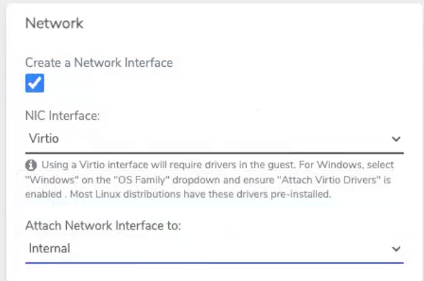
Network
-
Click Submit.
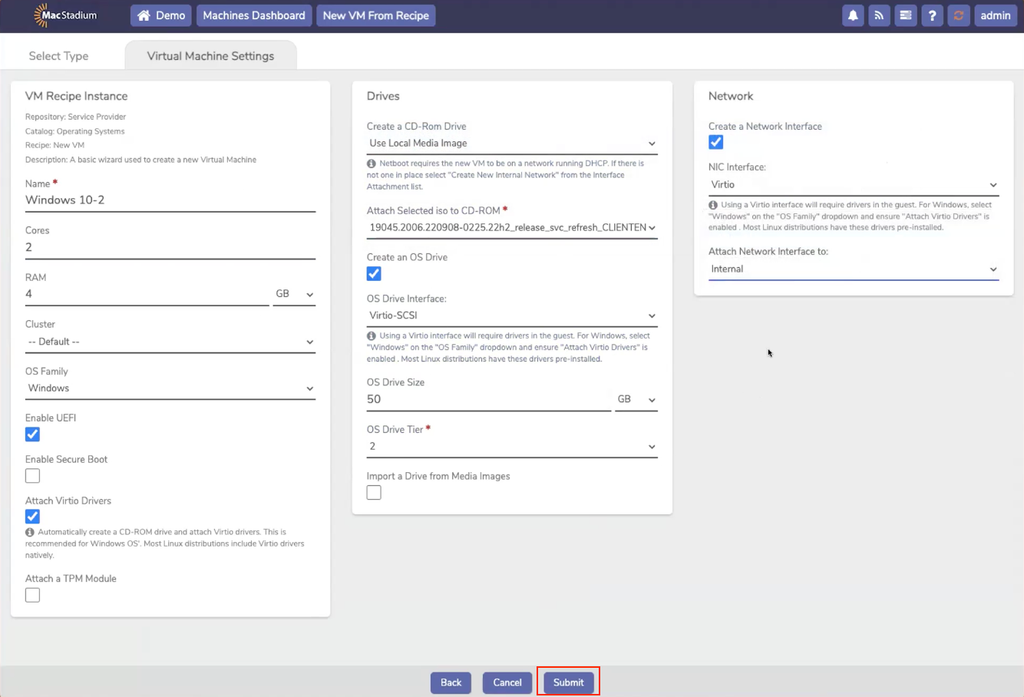
Virtual Machine Settings
- In the New VM (Windows) page, click Power.
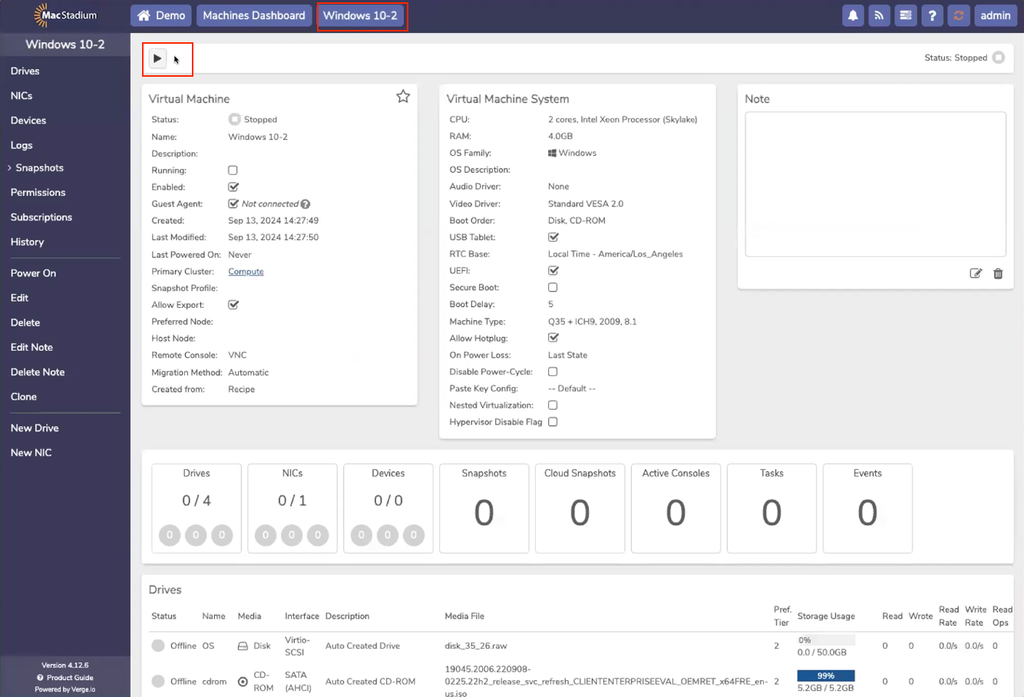
Power
- In the Confirmation box, click Power On.
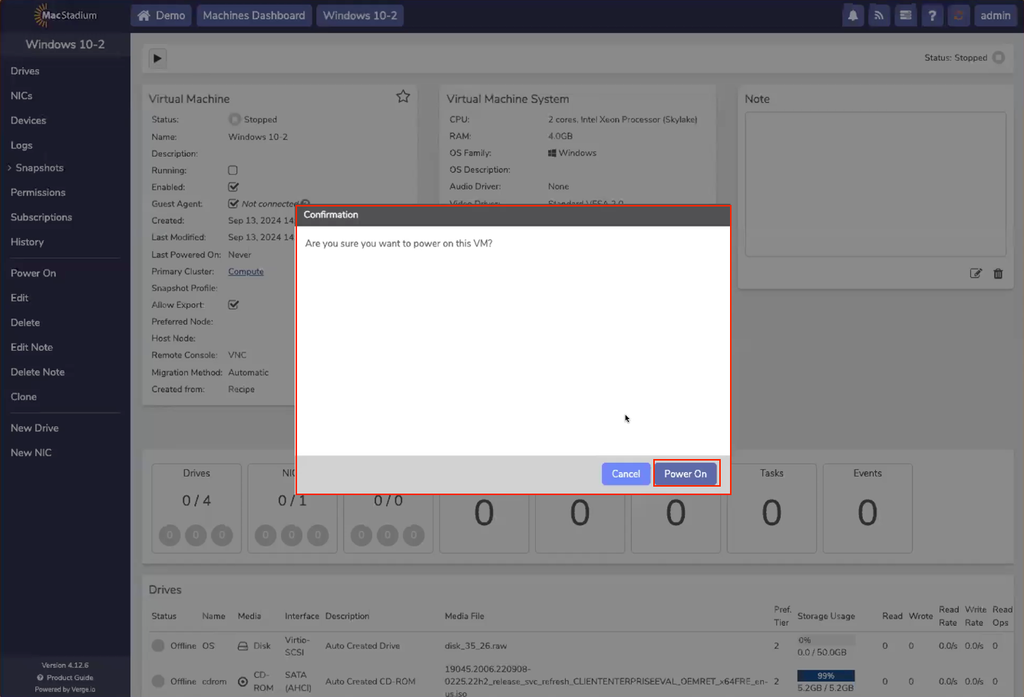
Power On
- Open the Console by clicking the Console button.

Console Button
- When prompted, press any key to begin installation.
- The Windows screen opens, click Next.

Windows
- Click Install Now.

Install Now
- Accept the license terms and click Next.

License Terms
- Select Custom: Install Windows Only (advanced).
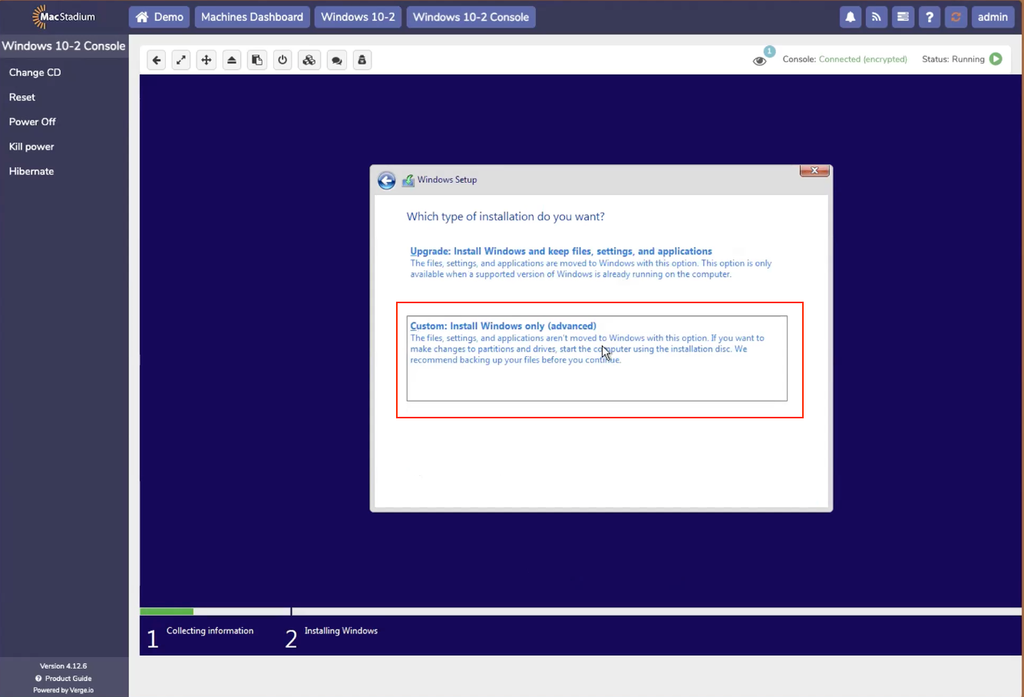
Custom Install Windows Only (advanced)
- The installation will fail to find any drives. At this point, the virtio storage drivers need to be loaded to continue the install. Click Load Driver.
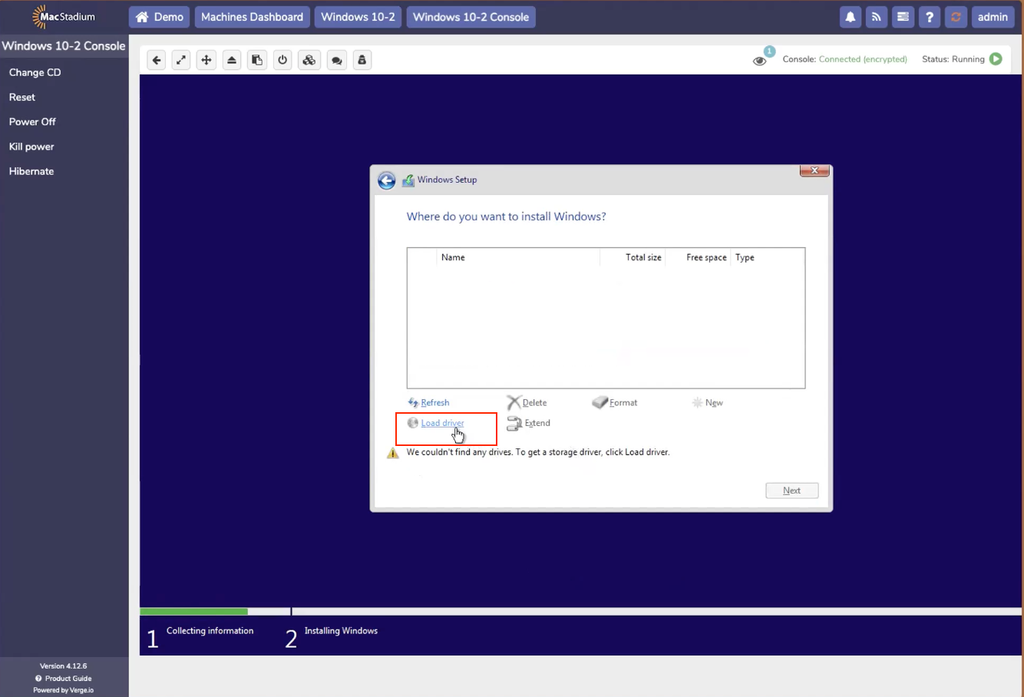
Load Driver
- Click OK.
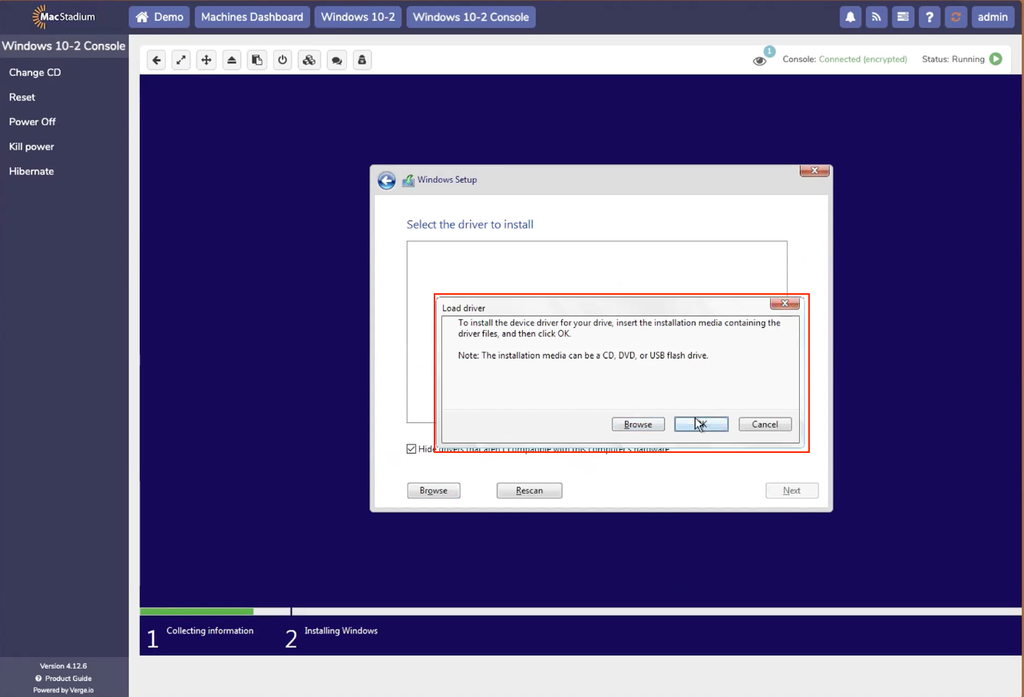
OK
- Select the driver for the corresponding Windows version, according to the folder name. For example, the Windows 10 driver is located in E:\amd64\w10.
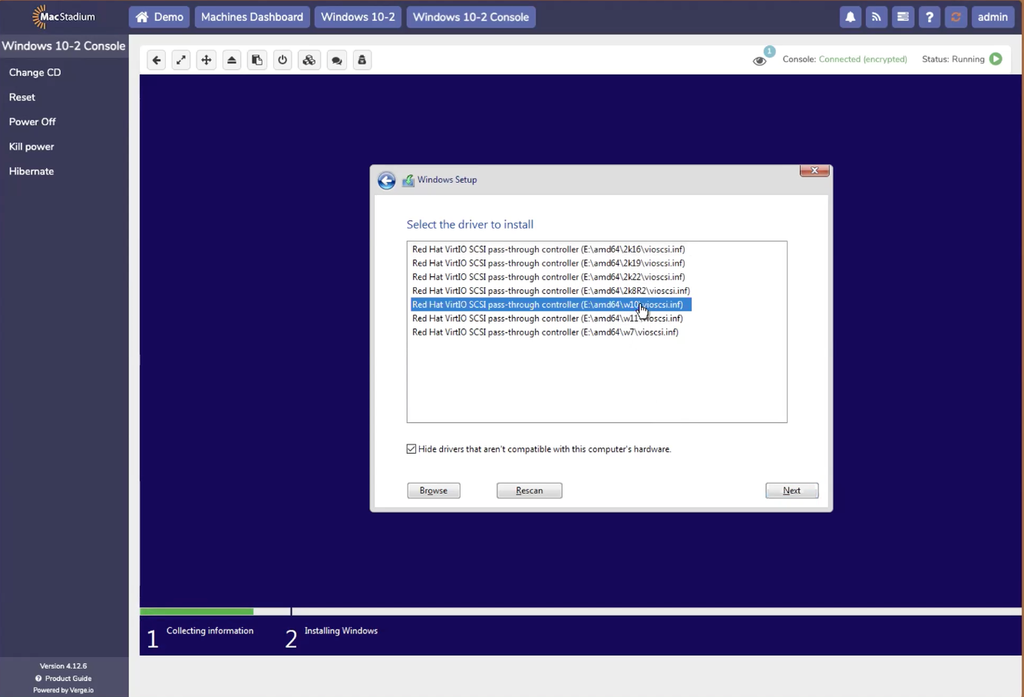
Windows 10 Driver
- Windows begins to install. Allow the installation to finish as usual. Network connectivity will not work during the install, this is expected, as Windows does not come with virtio network drivers.
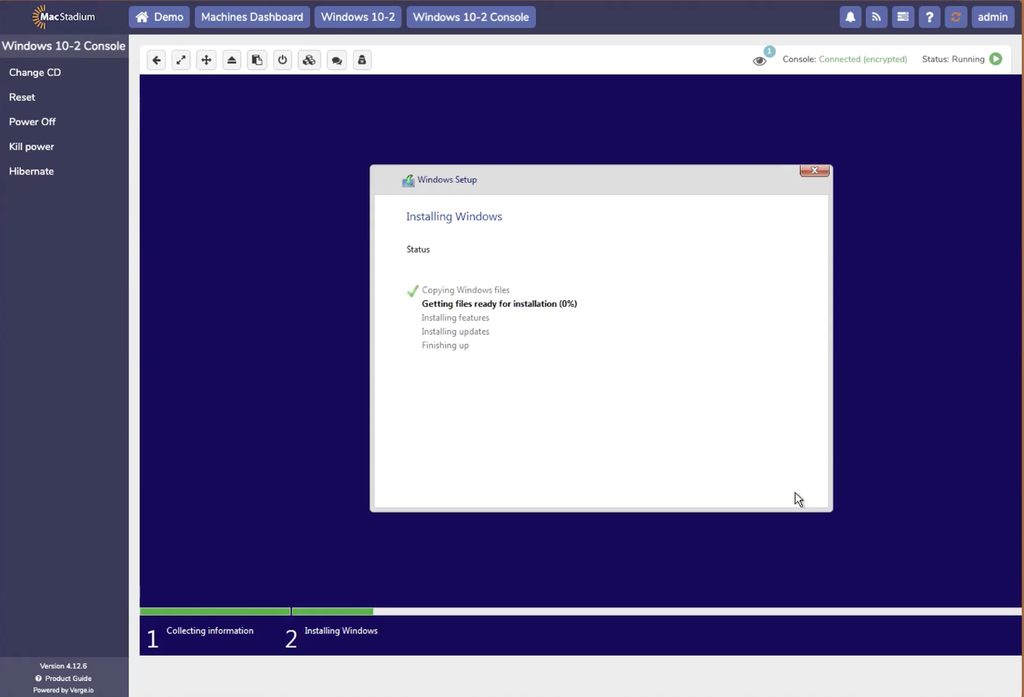
Installing Windows
- Once installed, additional drivers need to be installed to allow network connectivity. To do this, open Explorer, and navigate to This PC. A CD drive with virtio drivers should be accessible.
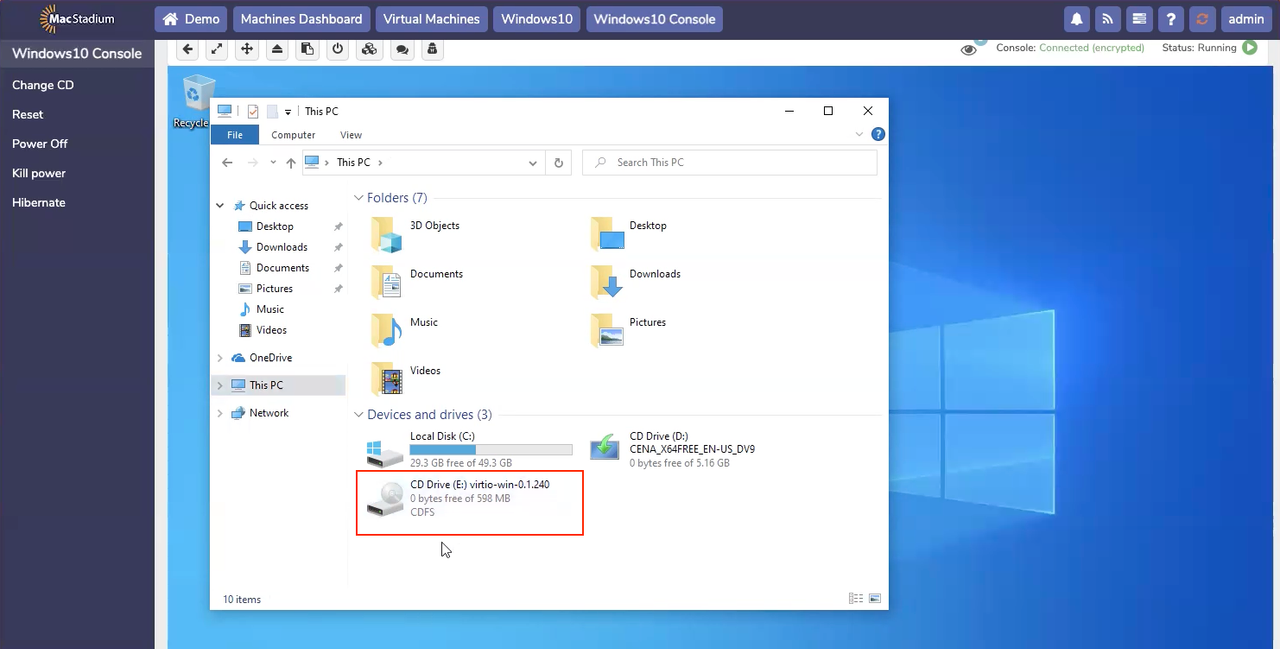
CD
- Double click on virtio-win-gt-x64.
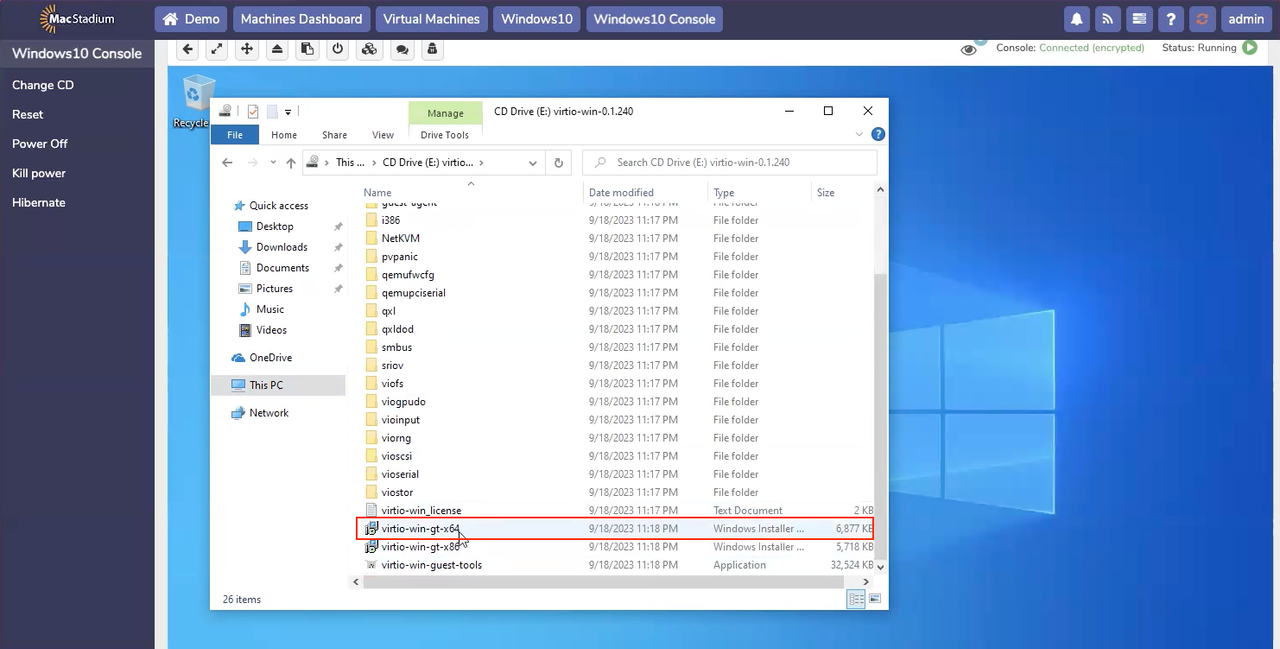
virtio-win-gt-x64
- When the Setup Wizard opens, click Next.
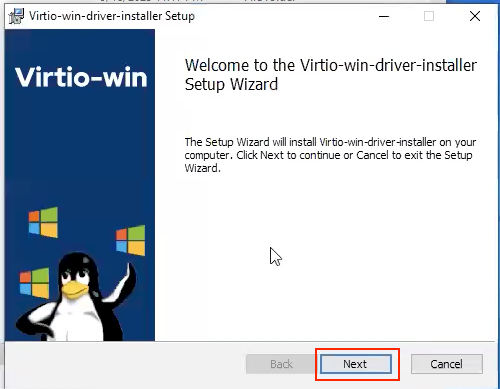
Setup Wizard
- Accept the terms and click Next.
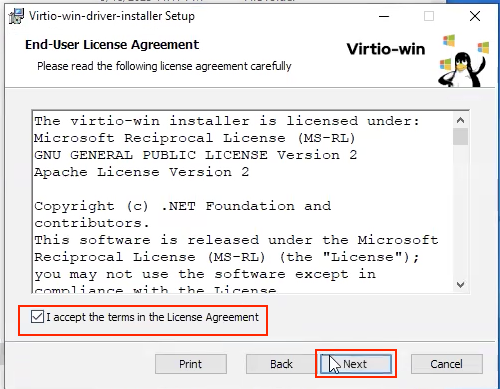
Terms
- Choose all and click Next.

All
- Click Install to begin the installation.
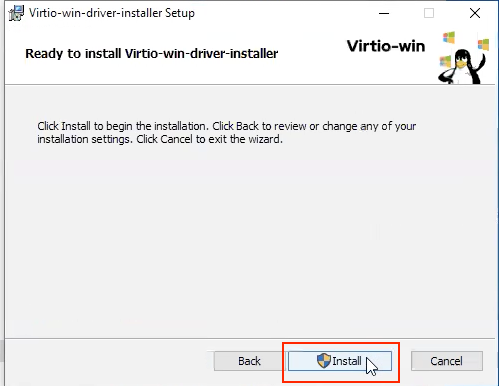
Install
- The progress bar appears.
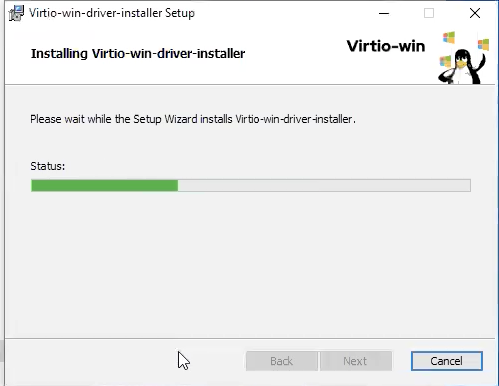
Progress Bar
- Click Finish to complete the Setup Wizard.
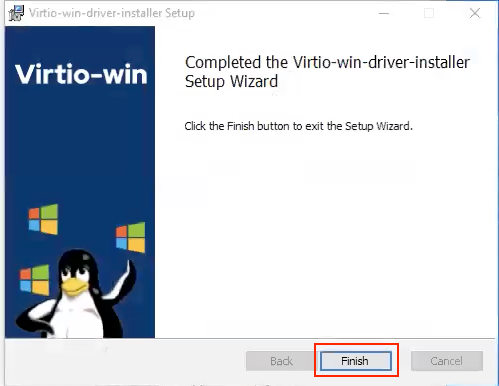
Finish
- Install Guest tools by clicking on the file virtio-win-guest-tools. Then accept the license terms and click Install.
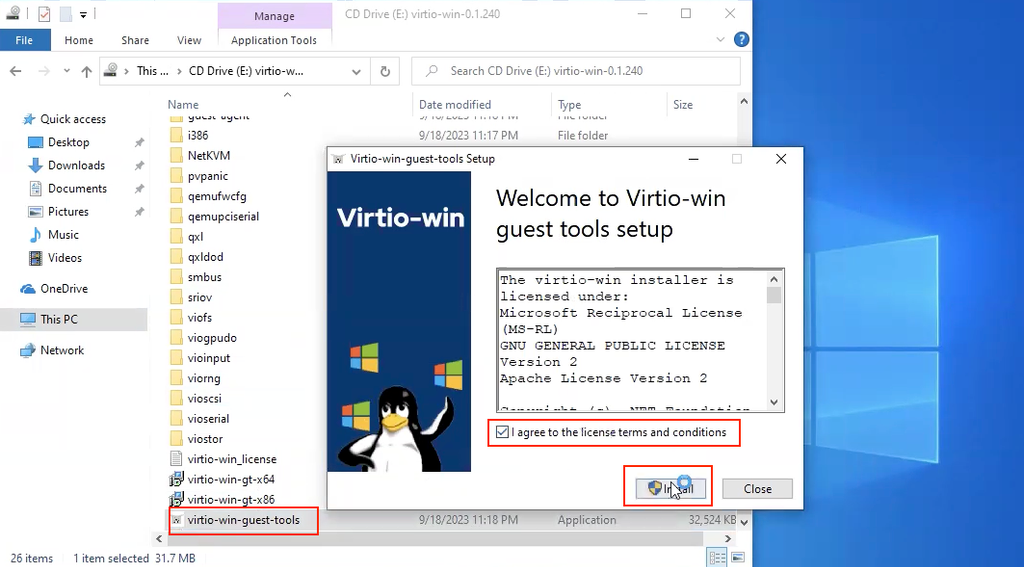
Install
- The progress bar appears.
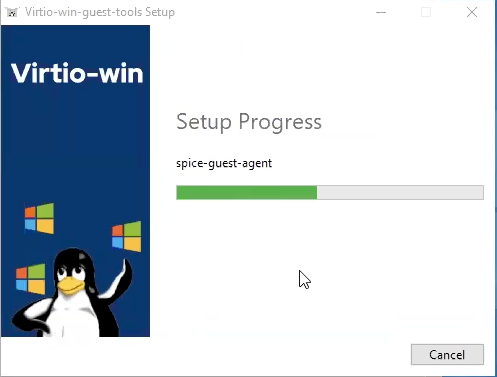
Progress Bar
- Click Close to complete the installation. Windows is now ready for use.
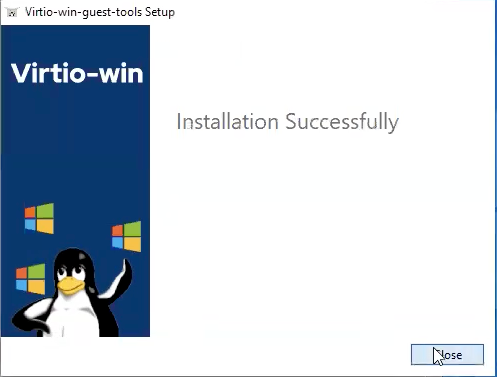
Close
Virtual Machines
About Virtual Machines
A virtual machine (VM) is a software-based computer that functions like a physical computer. VMs are created using hypervisor software, which allocates a physical computer's resources to the VMs. Each VM has its own operating system, memory, and other resources, which are isolated from other VMs on the same physical computer. Benefits of VMs include:
- Cost savings
VMs reduce the need for physical infrastructure, which saves on maintenance and electricity costs. - Scalability
VMs can be easily scaled by adding more physical or virtual servers to distribute the workload. - Security
VMs can run multiple operating systems without impacting the host operating system. - Disaster recovery
VMs can be used for backup and failover, which reduces the risk of data loss. - Testing
VMs can be used to test new applications or operating systems, or to access virus-infected data.
Overview Virtual Machine
This sections details the various screens and functions within the VM.
Virtual Machine
The Virtual Machine panel displays general Information about the virtual machine and its status. In other words, virtual machine information is displayed here.
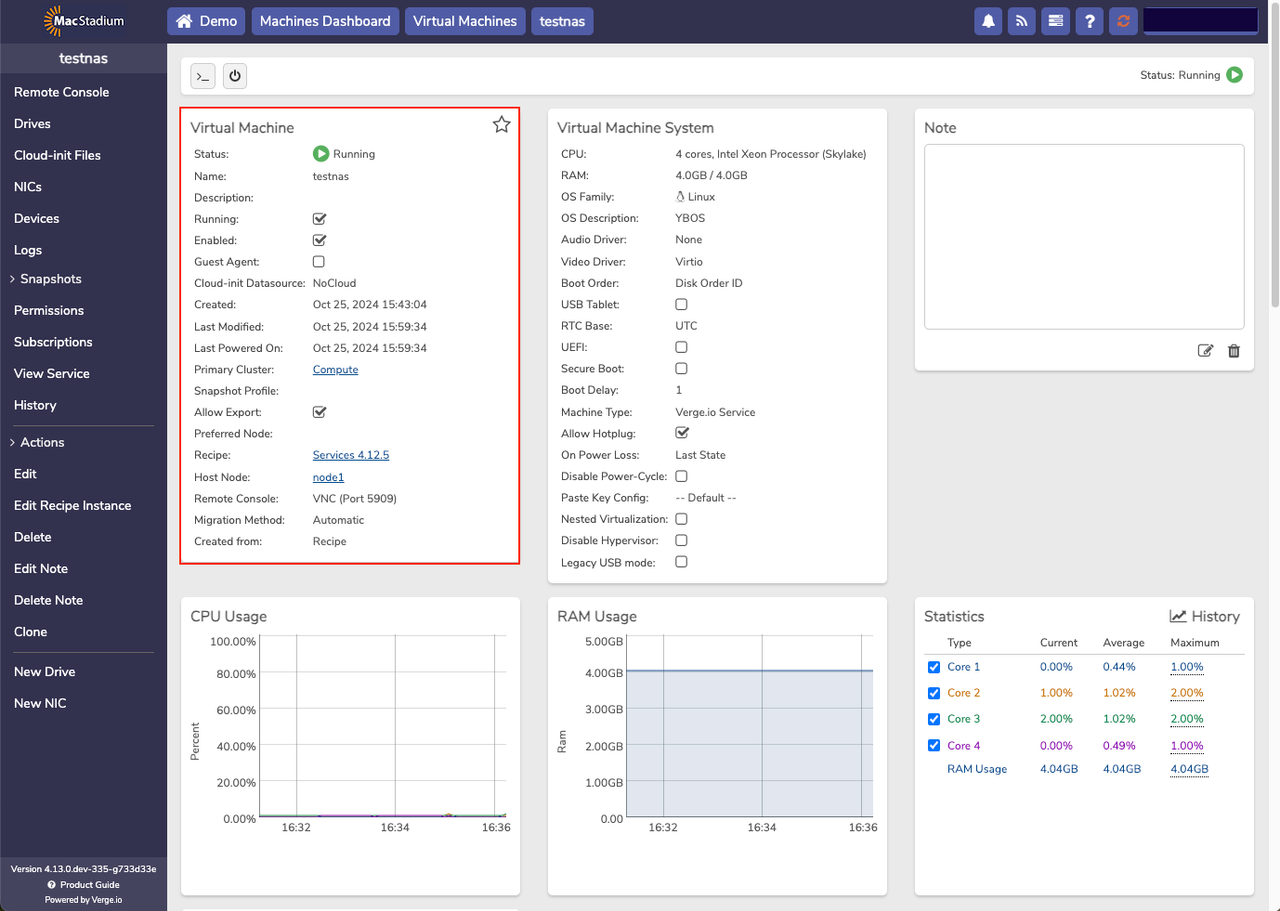
Virtual Machine
Virtual Machine System
The Virtual Machine System panel displays the specifications and detailed configuration settings for the virtual machine.
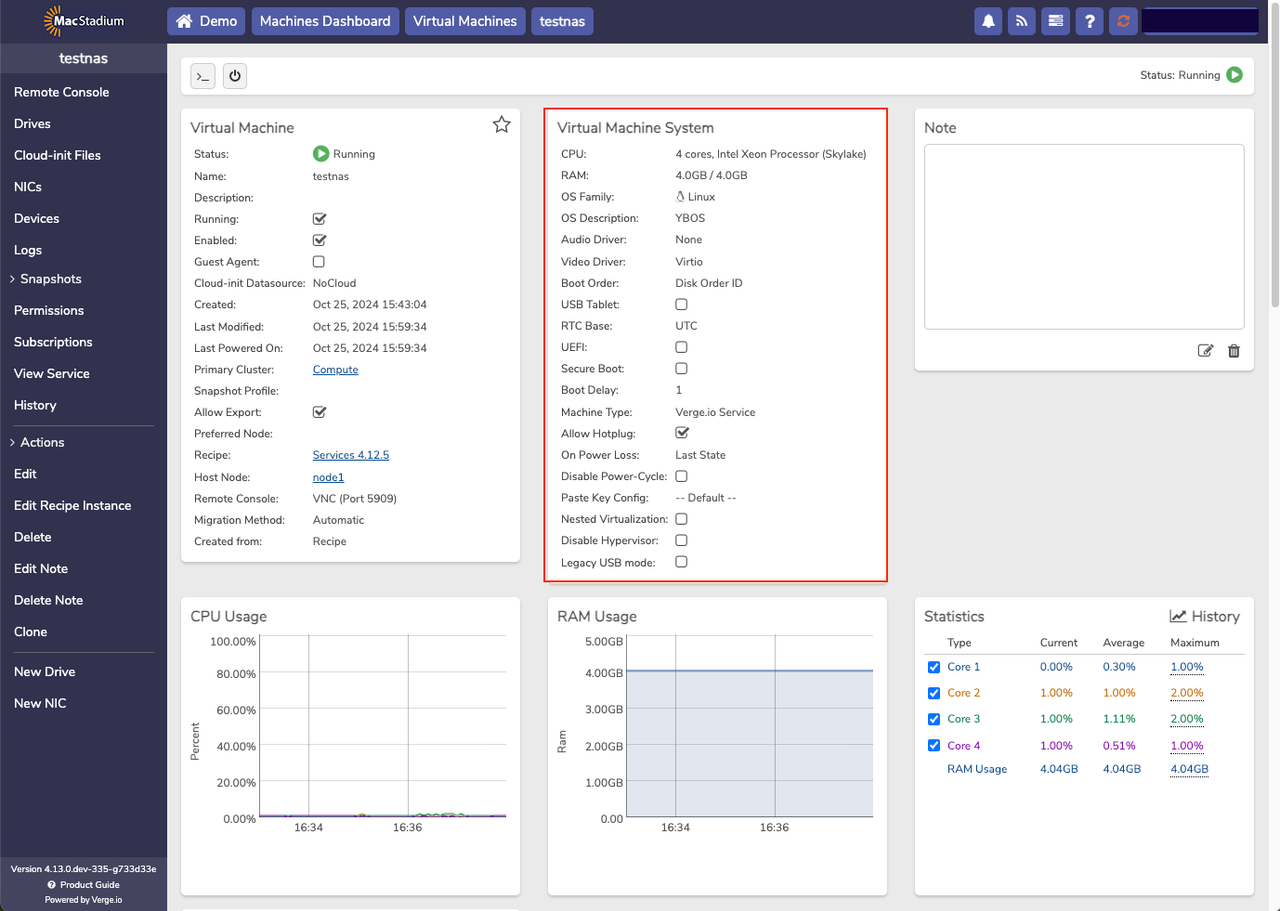
Virtual Machine System
CPU Usage
CPU usage is tracked here.
- Graphs
CPU, RAM, and storage usage is displayed in graphs that update every five minutes. - Statistics
Statistics for the current five-second heartbeat are displayed, along with historical information for five-minute intervals. - History links
Usage information for specific periods can be accessed using history links. - Dashboard
The most recent log entries are displayed on the Dashboard screen, with errors highlighted in red.
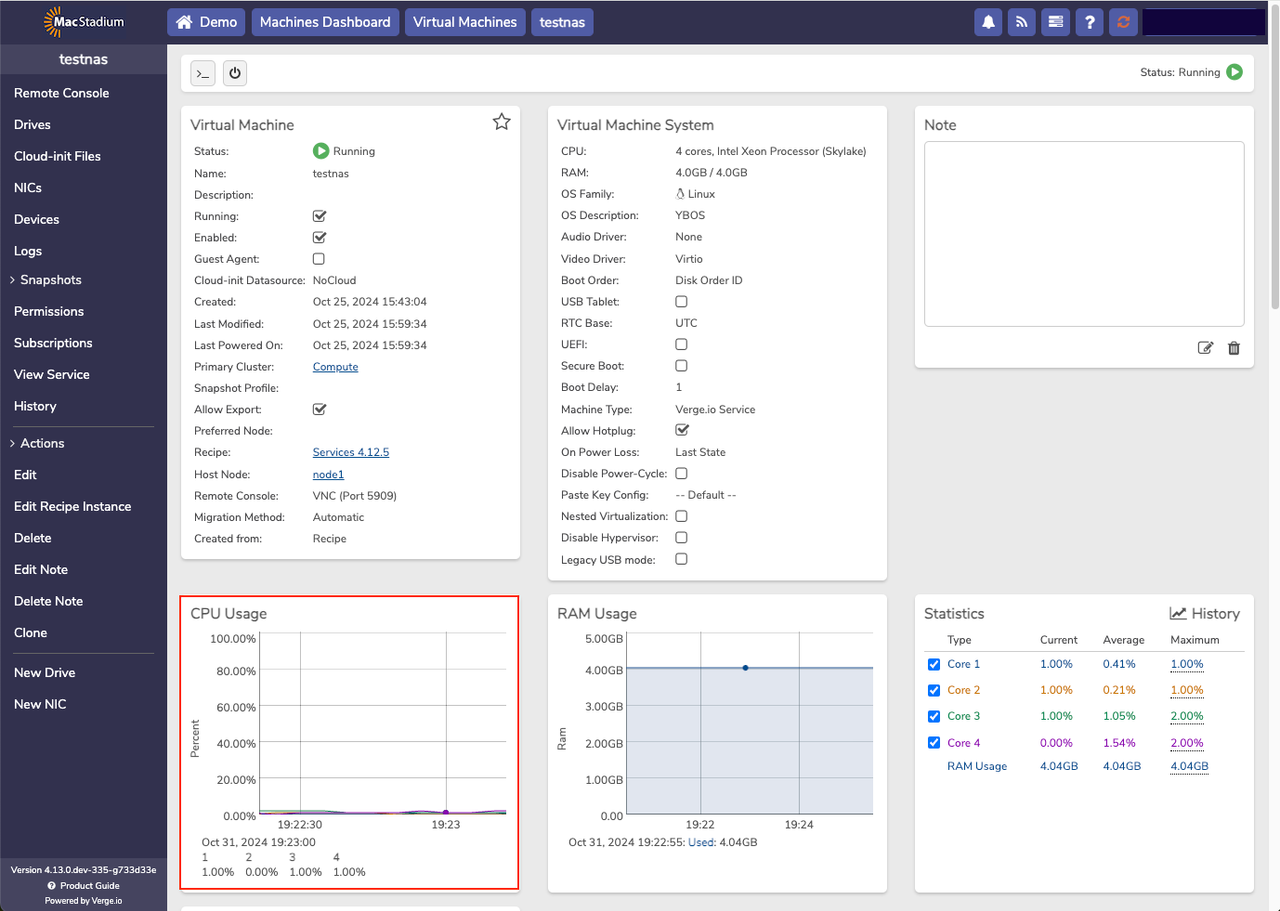
CPU Usage
RAM Usage
The RAM Usage panel displays historical RAM usage.
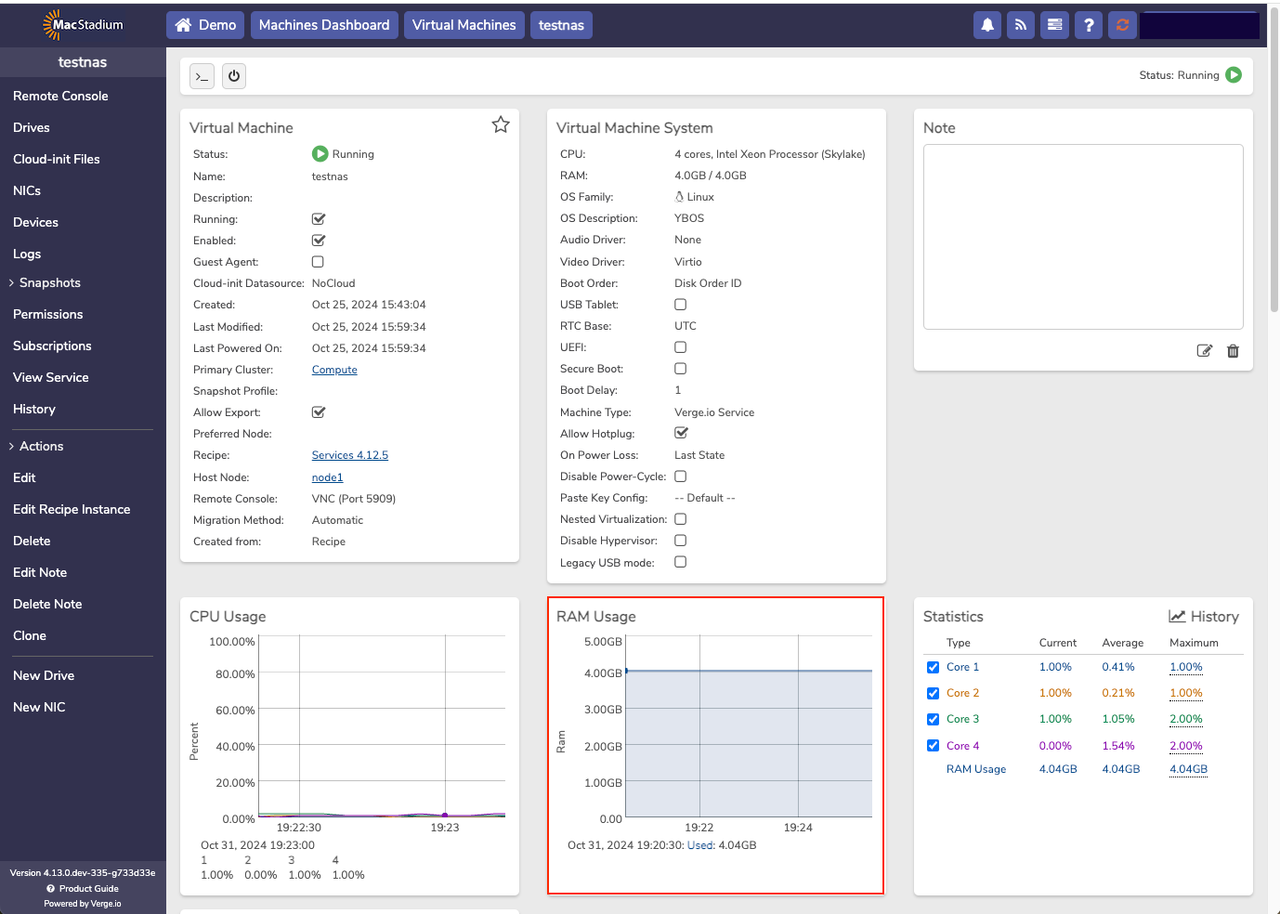
RAM Usage
- RAM Utilization - It is generally recommended to keep RAM utilization under 80% of the total available RAM.
- RAM Allocation for VMs - The amount of RAM to allocate to a VM should be enough to run its workloads. VMs can typically use less RAM than in other virtual environments because vSAN handles some functions automatically.
- Minimum RAM Requirements - A minimum of 8 GB of RAM for operations, plus 1 GB of RAM per 1 TB of storage in each server.
- Increasing Tenant Resources - When increasing a tenant's resources, add cores or RAM to an existing tenant node or scale out with an additional node.
- Adjusting RAM Allocation - Customers can adjust RAM allocation to achieve more frequent snapshots without affecting system performance.
Notes
A space is provided here to add notes about the VM here.
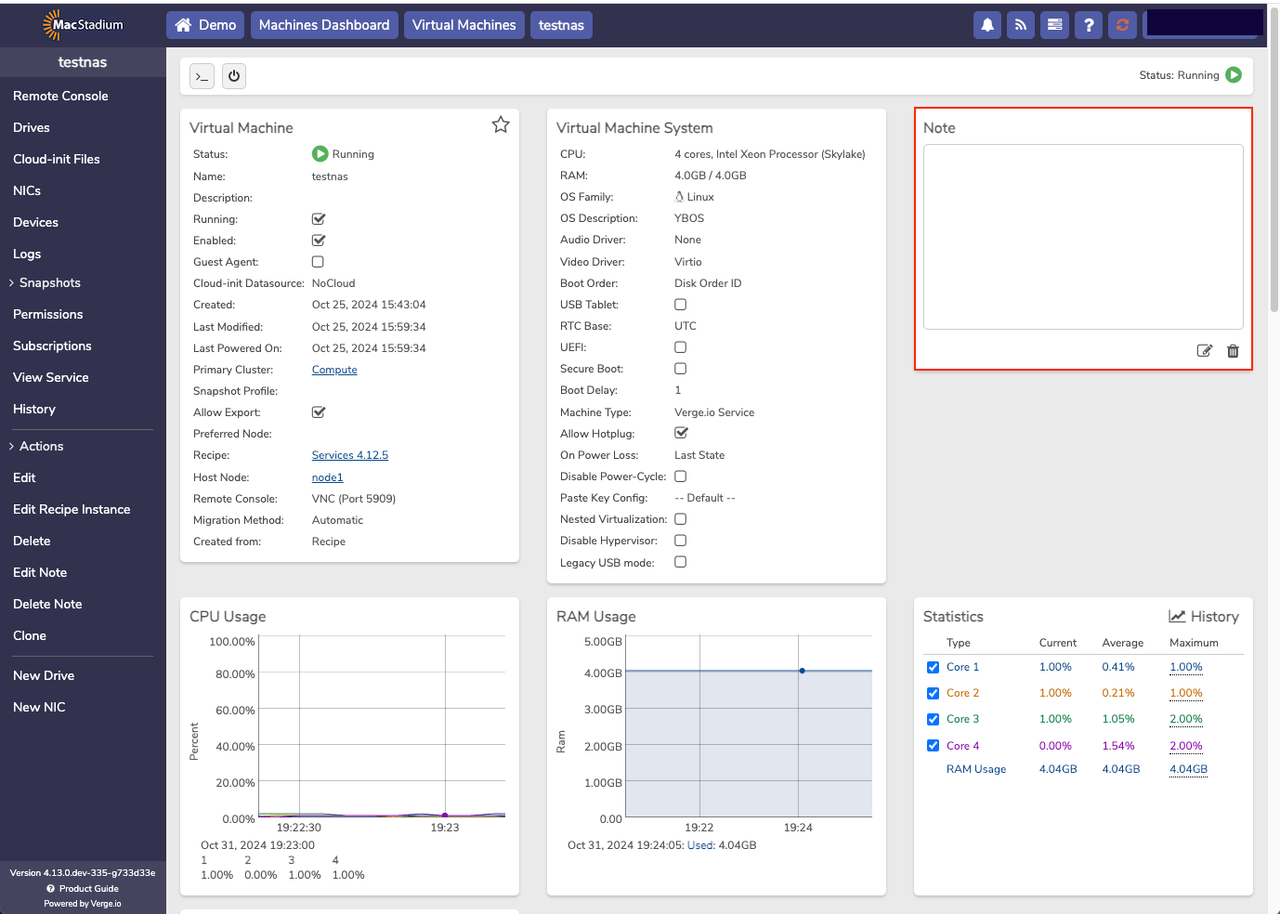
Notes
Statistics and Historical Statistics
- Information about firewall and network statistics is here.
- Click on History to open the Historical Statistics information screen.
- To view historical statistics, click the History link in the relevant section of the user interface.
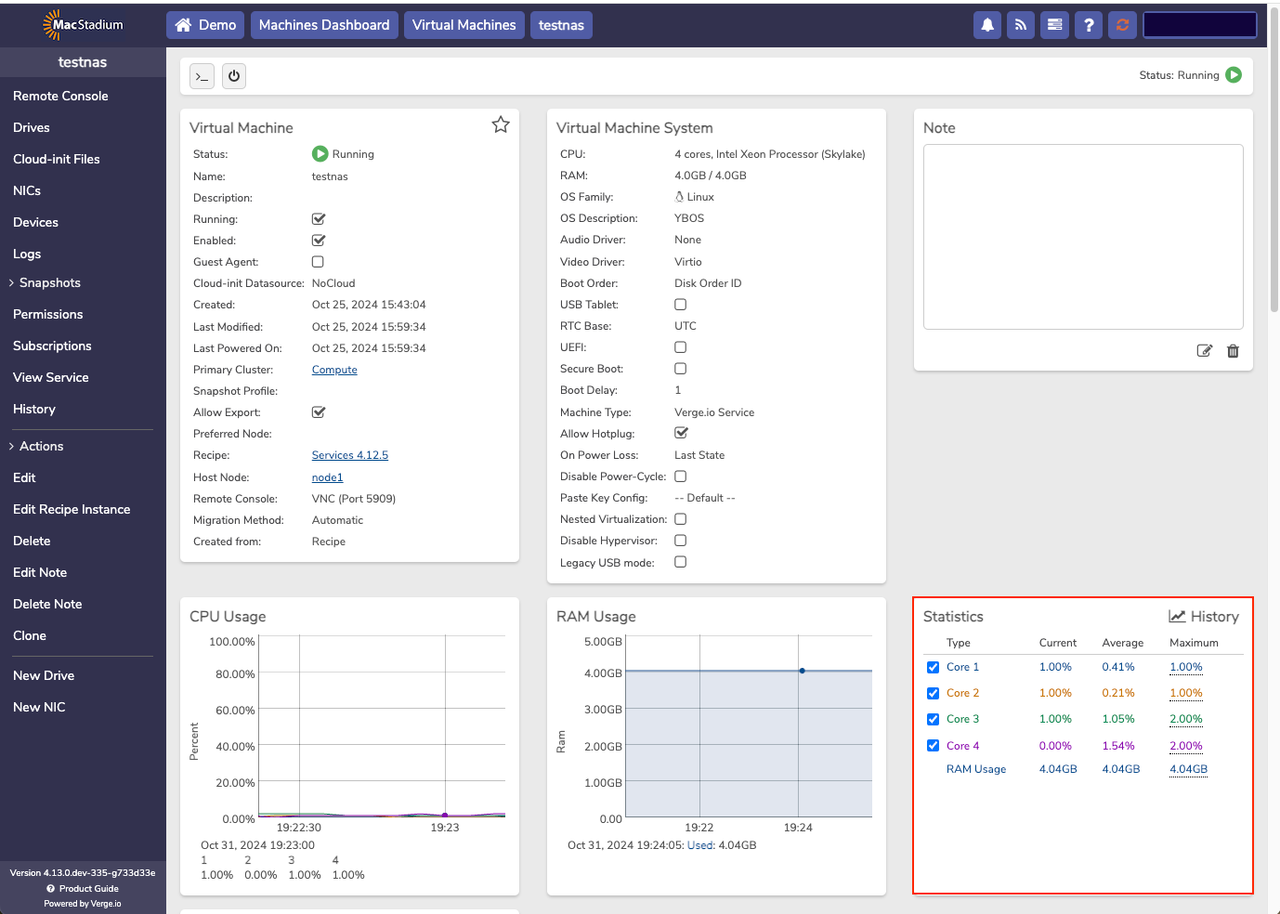
Statistics
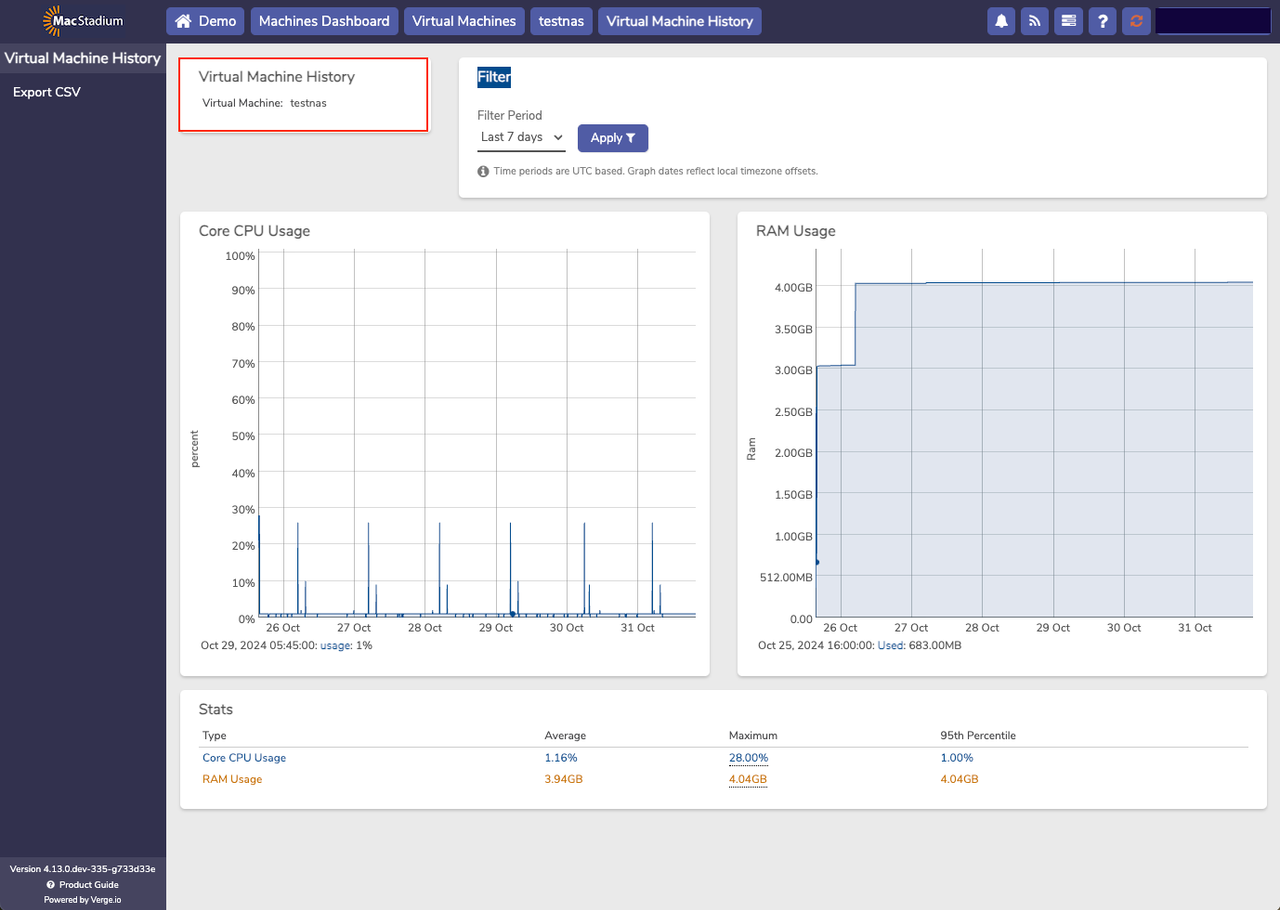
Historical Statistics
Drives
Note:
When Name is not specified, the system automatically names drives in order as created, drive_x where x is an integer starting with 0.
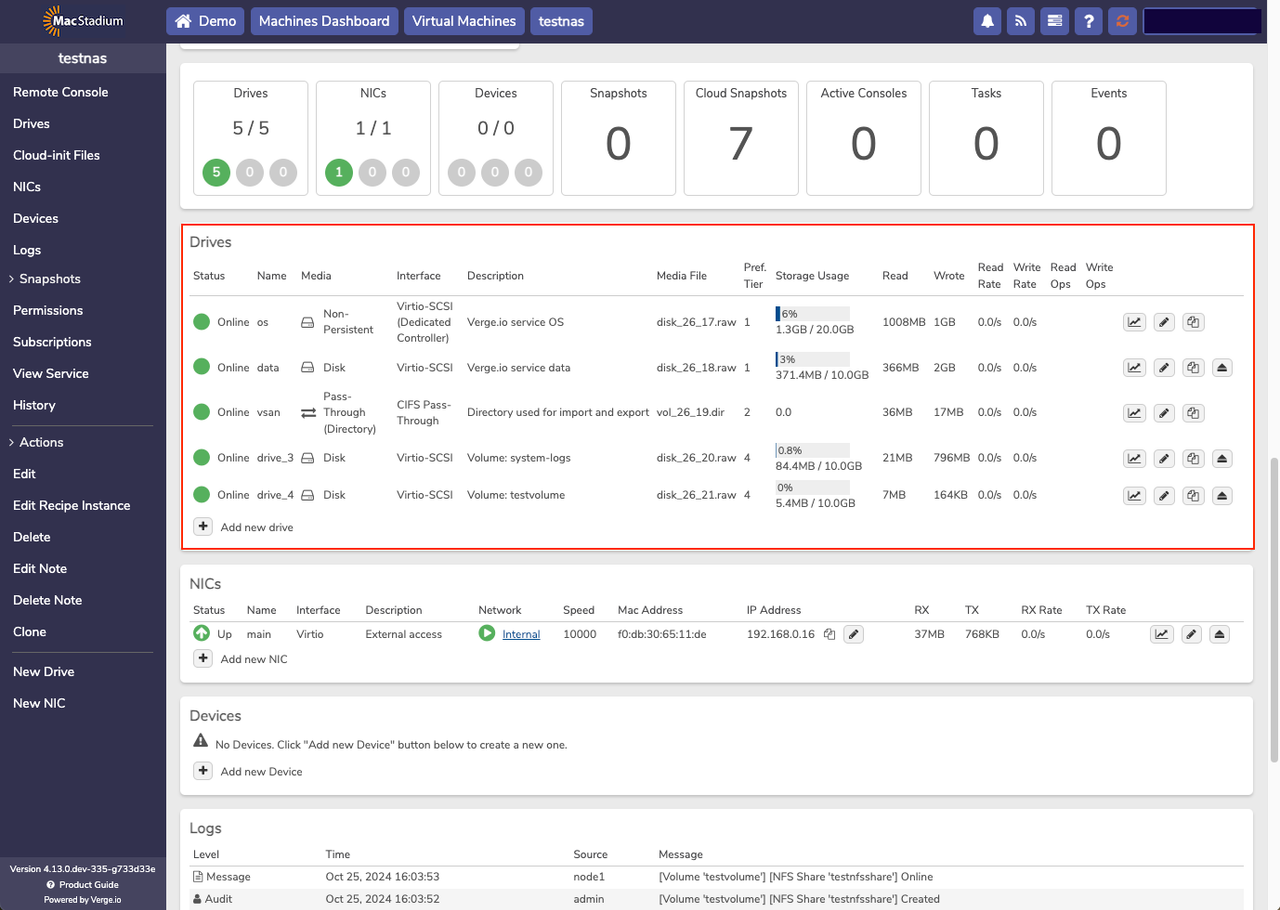
Drives
NICs
A network interface (NIC) enables a virtual machine (VM) to communicate with internet and on-premises resources.
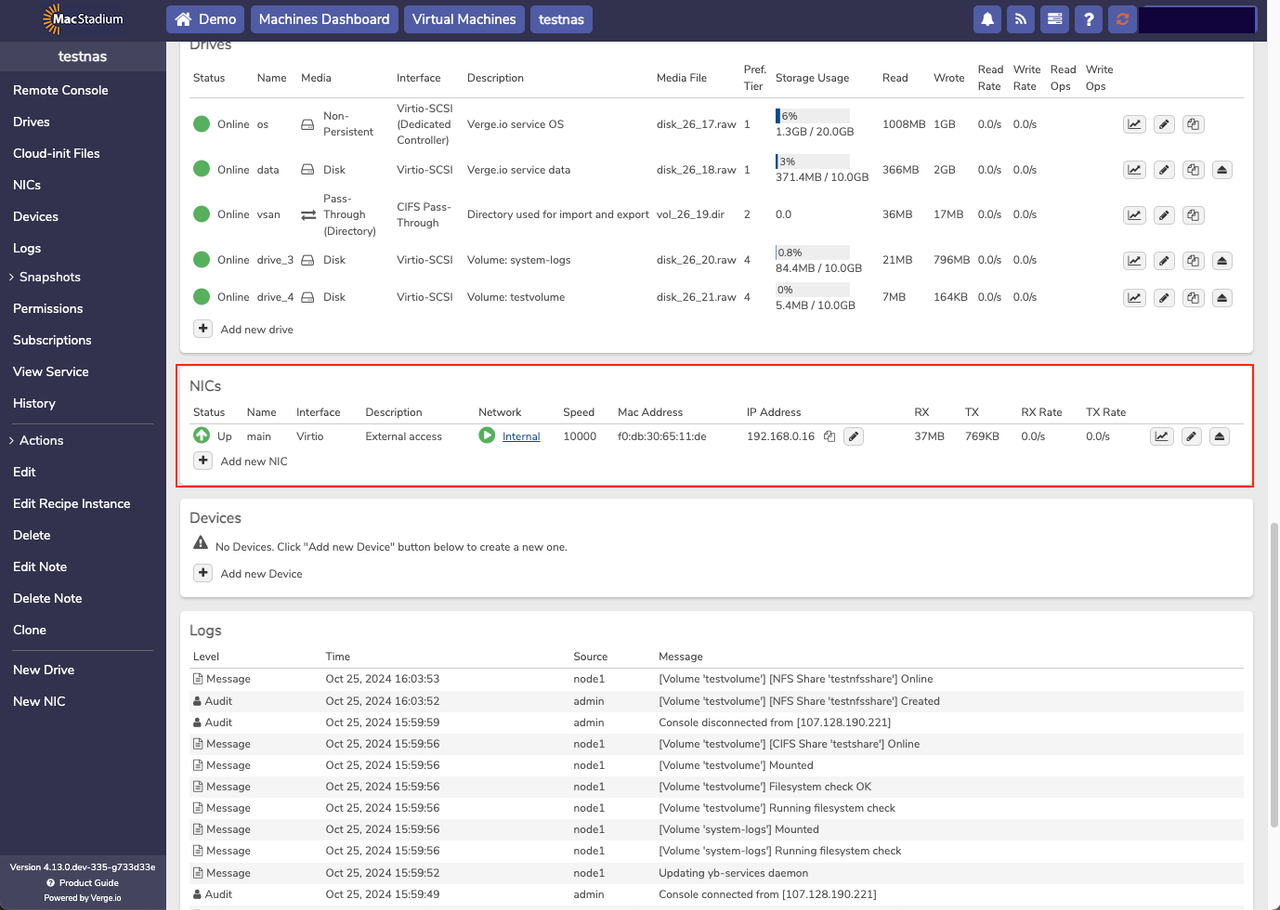
NICs
Note:
It is possible to modify a NIC Network field to --None-- to “unplug" it from the network while the VM is running. This does not require a reboot.
Devices
For Private Cloud, only vTPMs are supported, and are primarily used to run Windows.
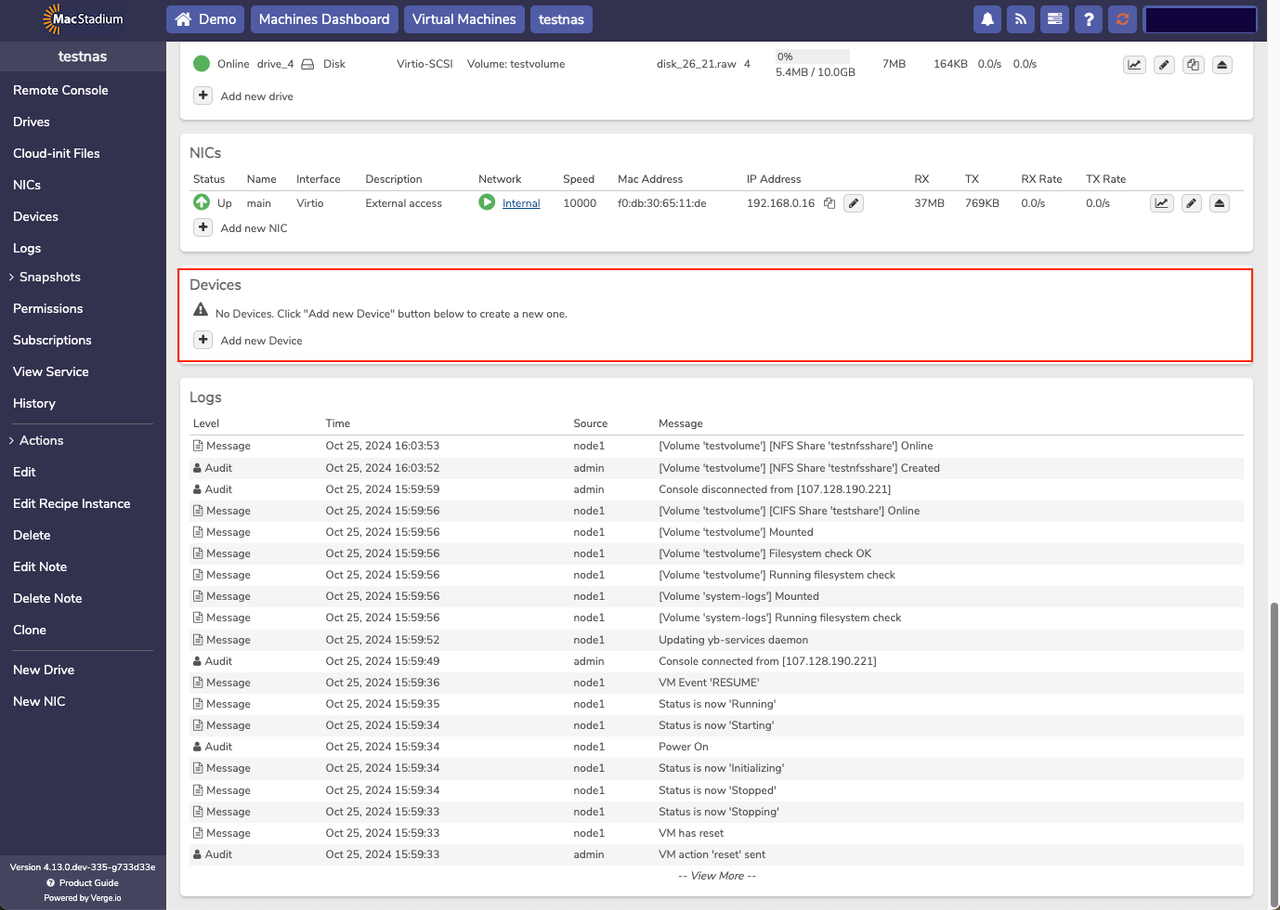
Devices
Logs
Information about logs is displayed here. System logs can be reviewed from the Main Dashboard at the bottom of the page or by selecting the Logs button in the left navigation menu.
Private Cloud keeps logged activity for a maximum of 45 days.
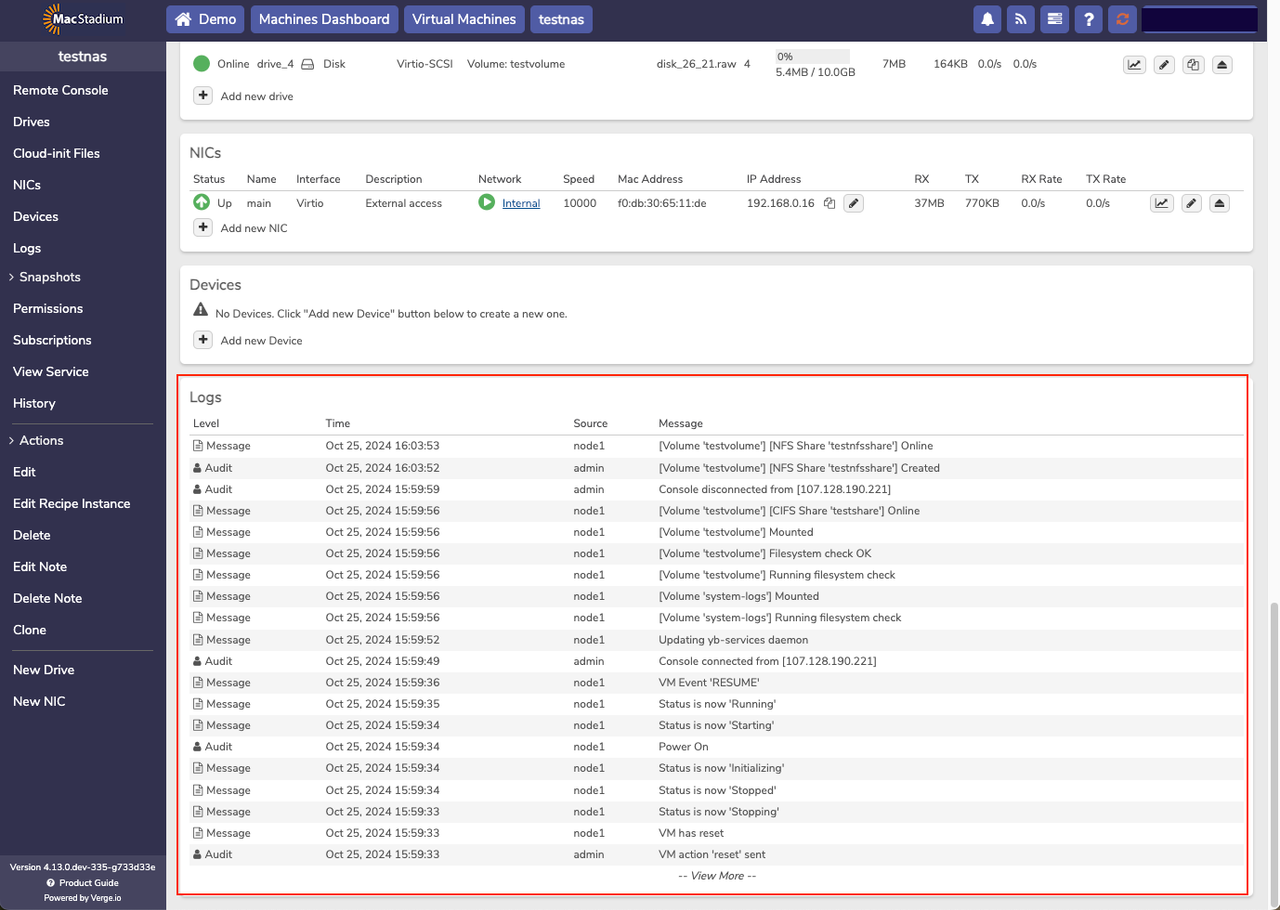
Logs
Bulk Machine Management
To perform an action on a large group of machines, use bulk options. For example, if there is a need to power on a large group of machines, then performing the task individually can be time consuming, while using the bulk option is much faster.
Select the checkbox in the upper lefthand corner to select all VMs, or individually click multiple VMs to select specific VMs to update.
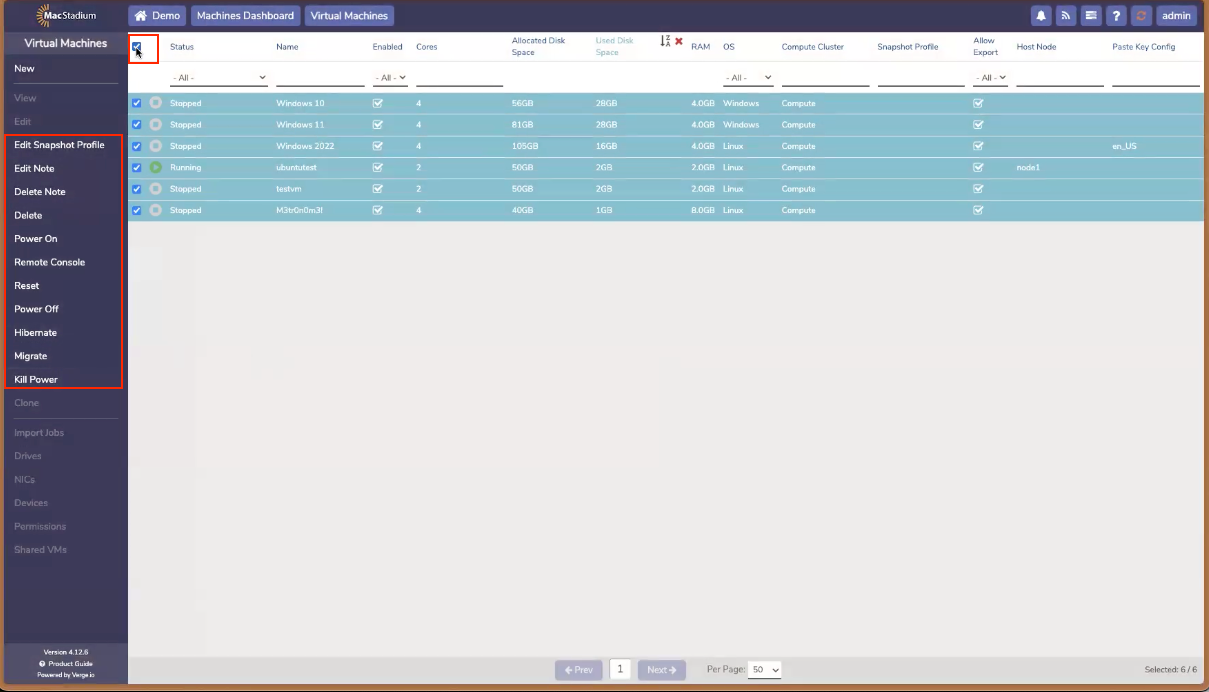
Bulk Options
Start One or More VMs at Once
- Navigate to Machines > Virtual Machines, which brings up the VM listing.
- Select the desired VMs. (Selected VMs display a checkmark once selected.)
- Click Power On on the left menu.
- Click Submit on the confirmation screen.
Edit Multiple Notes at Once
- Navigate to Machines > Virtual Machines, which brings up the VM listing.
- Select the desired VMs. (Selected VMs display a checkmark once selected.)
- Click Edit Note.
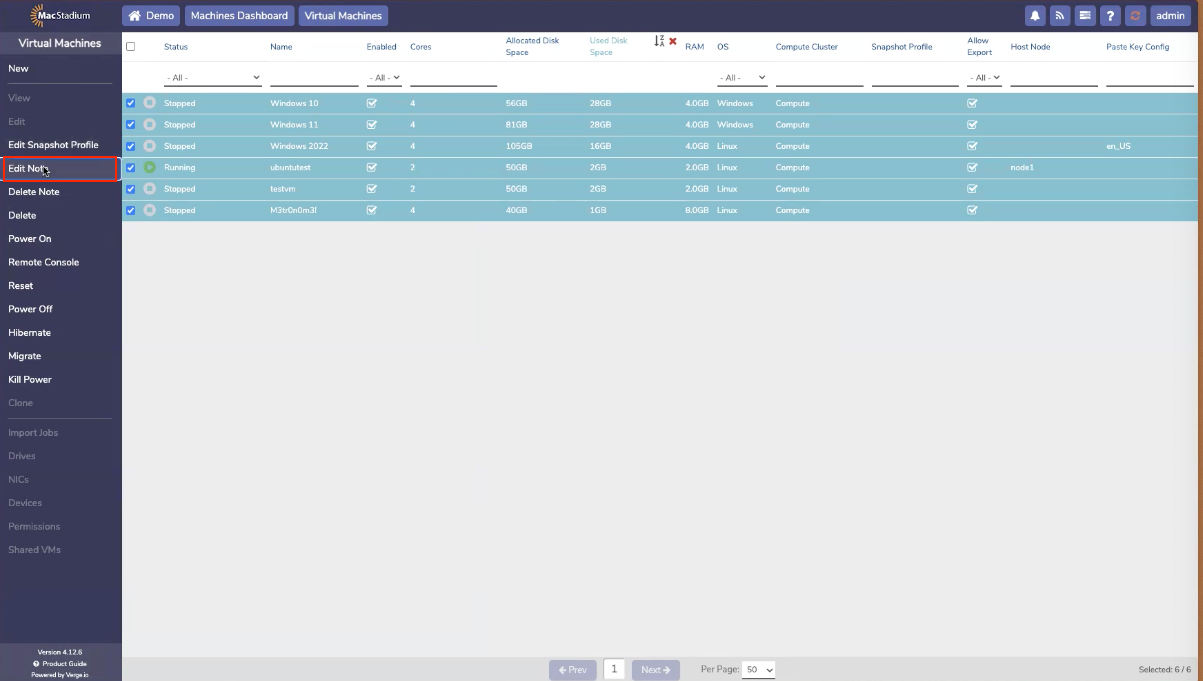
Edit Note
- Add a note then click Save.
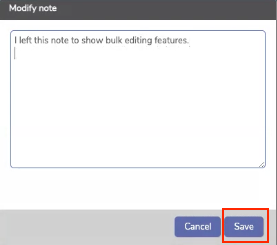
Modify Note
- A progress bar appears to show the note being added to each VM.
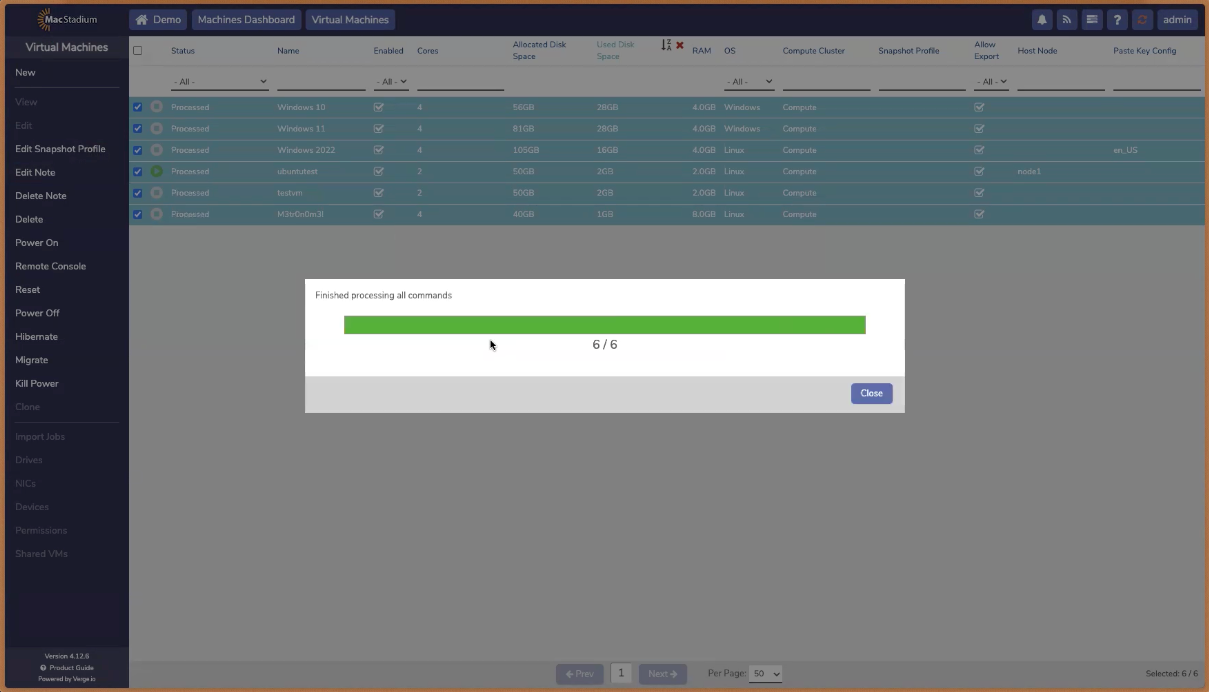
Note Progress Bar
- Select a VM and click on it to display the updated note.

Updated Note
Delete Multiple Notes at Once
- Navigate to Machines > Virtual Machines, which brings up the VM listing.
- Select the desired VMs. (Selected VMs display a checkmark once selected.)
- Click Delete Note.
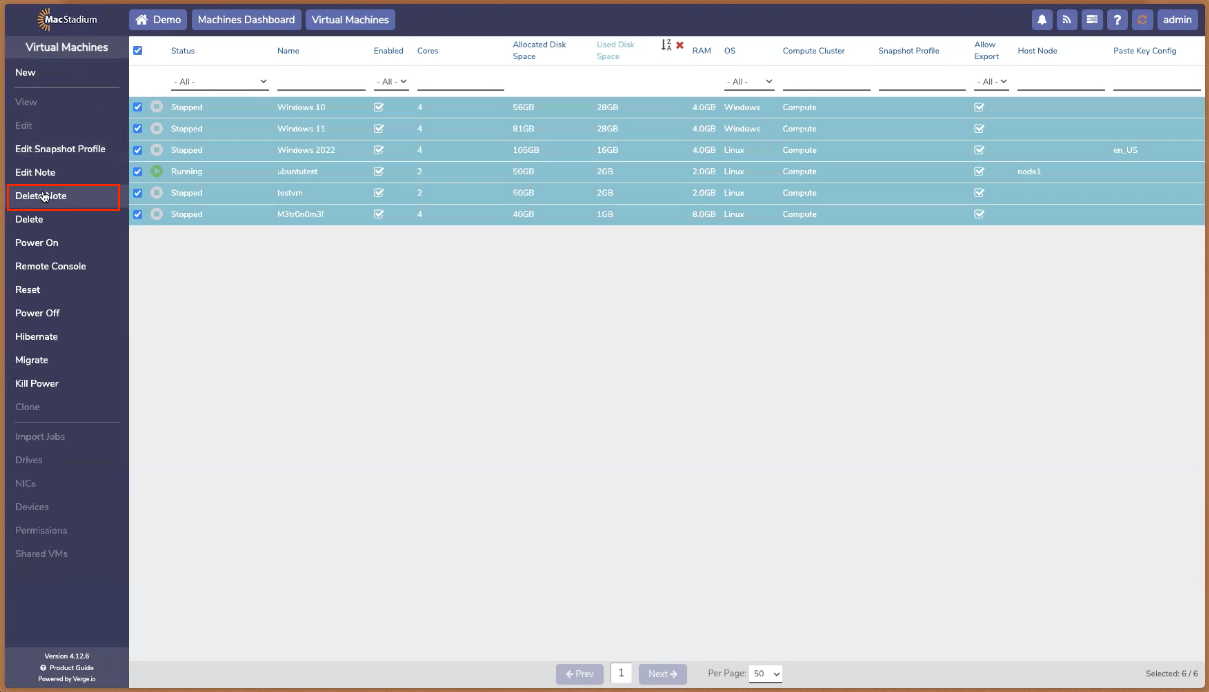
Delete Note
- In the confirmation box click Yes.
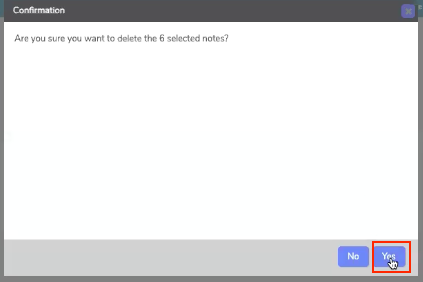
Confirmation Box
- A progress bar appears to show the note being removed from each VM.
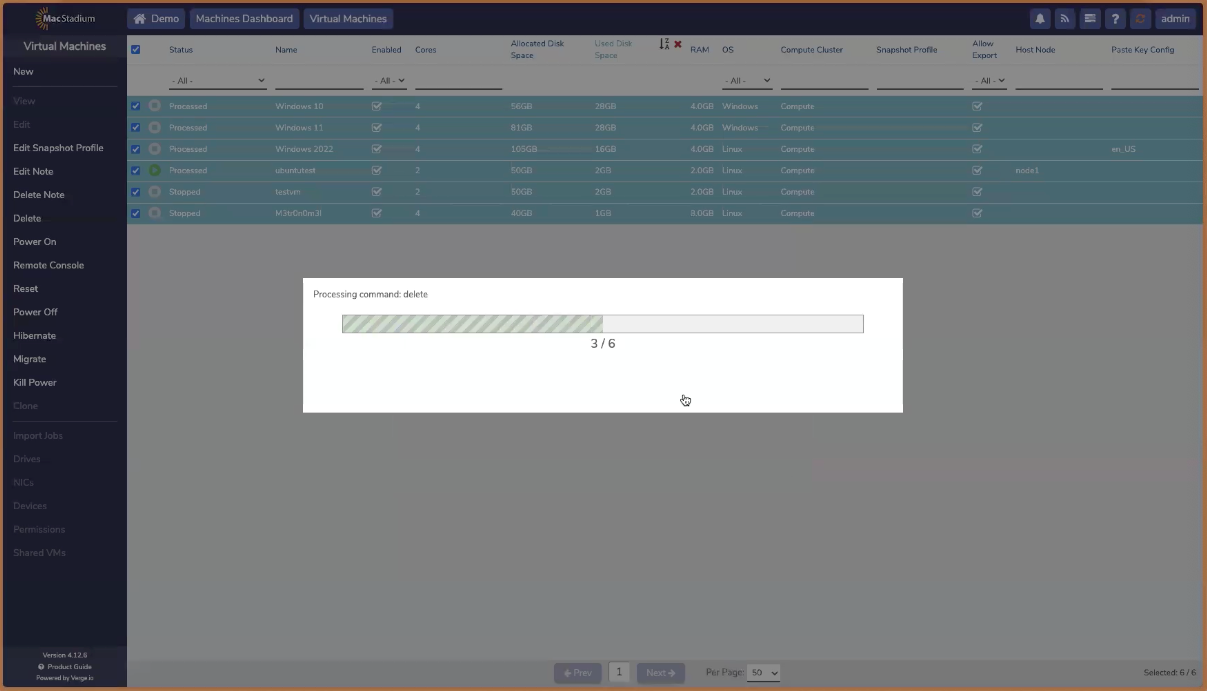
Progress Bar
- Select a VM and click on it to display the updated note.
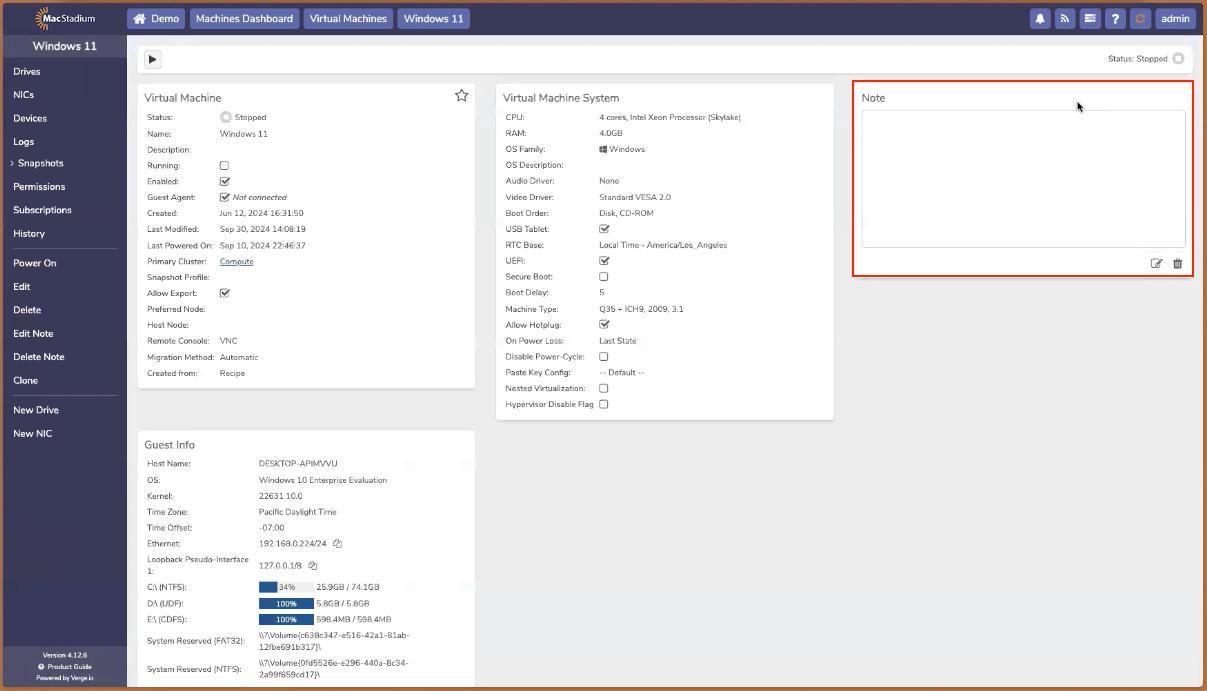
Remove Note
Delete Multiple VMs at Once
Note:
Considerations before deleting a VM:
- The system does not allow a VM to be deleted if it is running.
- Deleting a VM also deletes its VM snapshots.
- Cloud Snapshots that were taken when the VM existed will still contain a copy of the VM Navigate to Machines > Virtual Machines, which brings up the VM listing.
- Select the desired VMs. (Selected VMs display a checkmark once selected.)
- Click Delete.
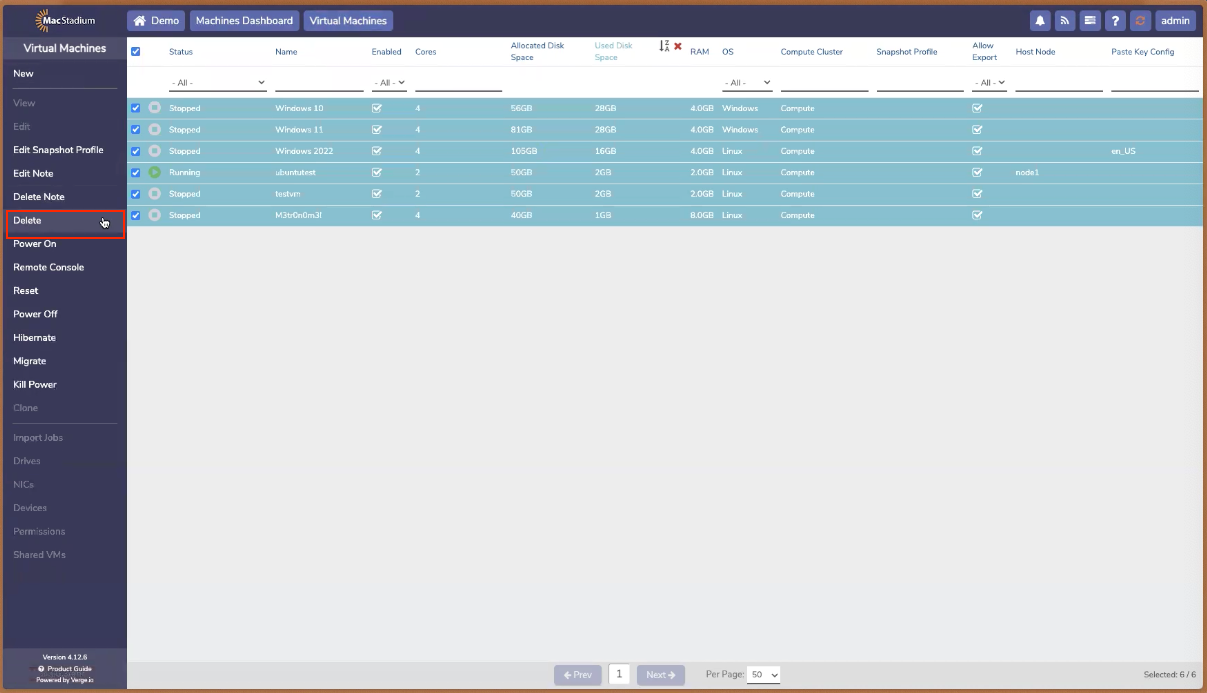
Delete VMs
- In the confirmation box click Yes.
Remote Console Multiple VMs at Once
The Remote Console function creates a tab for each VM selected and opens a console window, which is convenient for managing a cluster of machines.
Note:
The bulk edit function may be used to open multiple Remote consoles at once, with a tab for each VM selected. This is convenient for managing a cluster of machines.Navigate to Machines > Virtual Machines, which brings up the VM listing.
- Select the desired VMs. (Selected VMs display a checkmark once selected.)
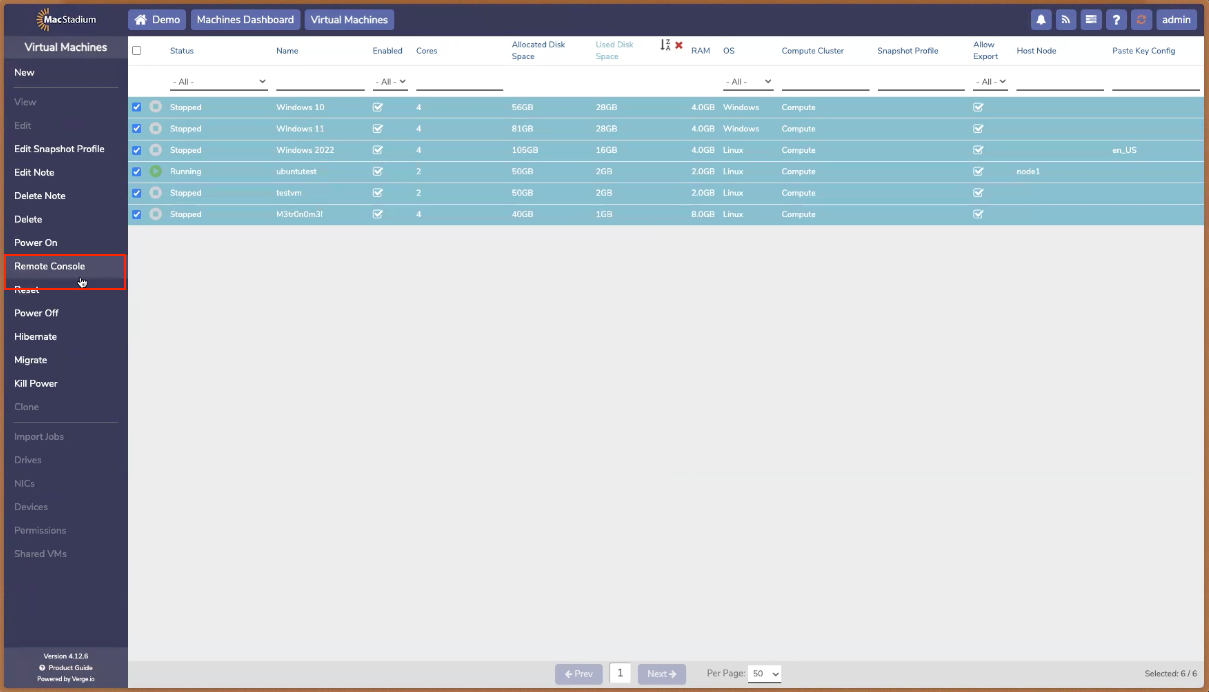
Remote Console
- Individual tabs are opened with a console for each selected machine.
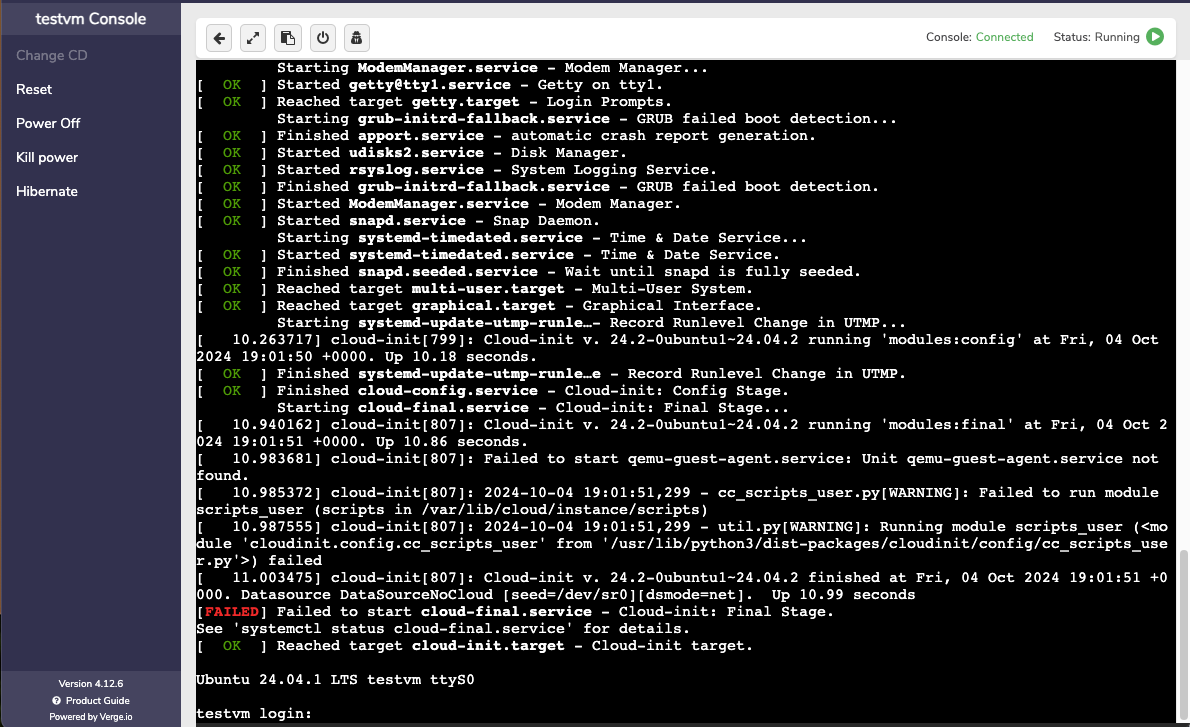
Open Console
Hibernate Multiple VMs at Once
The hibernate function stops the VM’s operation, without powering down. The benefit of hibernating is that the machine can be quickly resumed without consuming resources while hibernated. Think of the VM being in a frozen state, with its RAM written to disk for future retrieval.
- Navigate to Machines > Virtual Machines, which brings up the VM listing.
- Select the desired VMs. (Selected VMs display a checkmark once selected.)

Hibernate
- In the confirmation box click Yes.
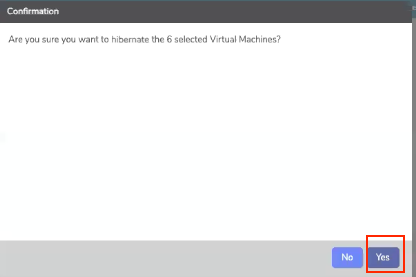
Hibernate Confirmation
- The VM now appears hibernated in the dashboard.
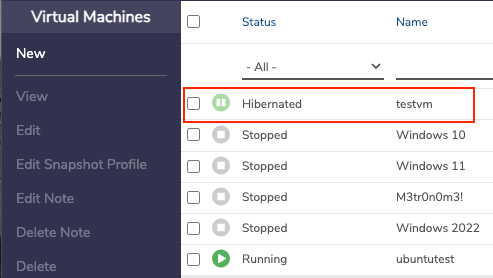
Hibernate
Note:
When a hibernated machine is powered on, it resumes operation in the same state it was in when hibernated, without requiring a full boot.
Reset Multiple VMs at Once
- The Reset function of a VM forcibly reboots the virtual machine. Resetting a virtual machine is the equivalent of pushing the reset button of a physical machine. It initiates a hard reset of the operating system without changing the power state of the virtual machine.
Power Off Multiple VMs at Once
- The Power Off function sends the shutdown command to selected virtual machines. This will gracefully power off the virtual machines, and is the recommended method to stop running VMs.Kill Power to Multiple VMs at Once.
- The Kill Power function of a VM is equivalent to unplugging the power cable from a physical machine. It can be used to immediately stop the operation of a virtual machine, with the risk of data loss or filesystem damage. This can be helpful if the virtual machine is in a frozen or locked state and is unresponsive to the power off command.
Importing a VM from Media Images
Importing via Media Images allows users to import a single VM at a time. First, by uploading VM data files (such as VMX, VMDK, OVF, VHD/X) and then importing those files.
Note:
Hyper-V VMs should be exported to OVA/OVF or VMware formats before being upload.
- Upload the configuration and disk image files to the vSAN.
- From the Main Dashboard, click Machines.
- Click New VM.
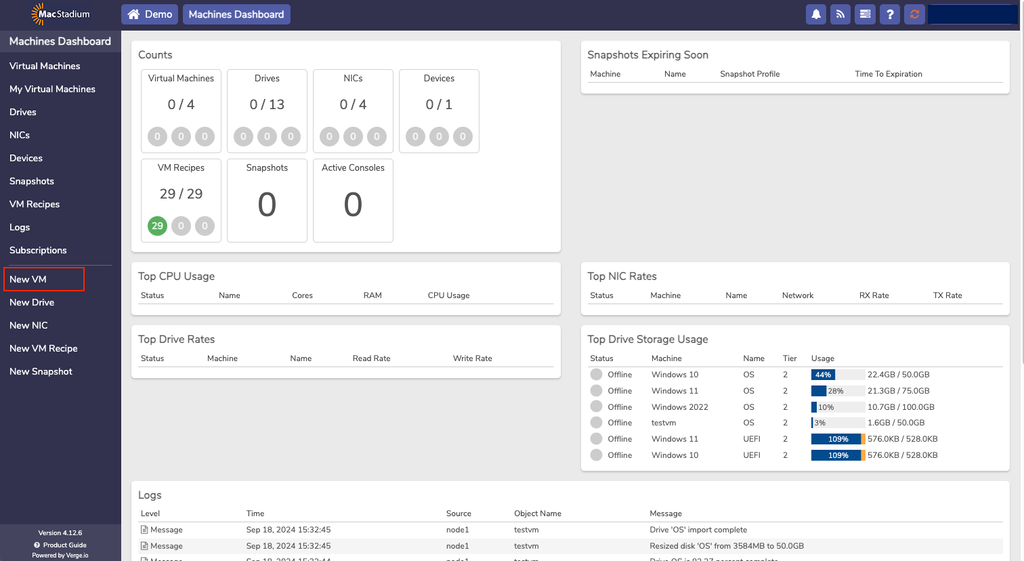
New VM
- Select Import from Media Images. The files uploaded to the vSAN appear on the right under Selections Available.
- Click to select the VM configuration file (for example, .vmx, .ovf).
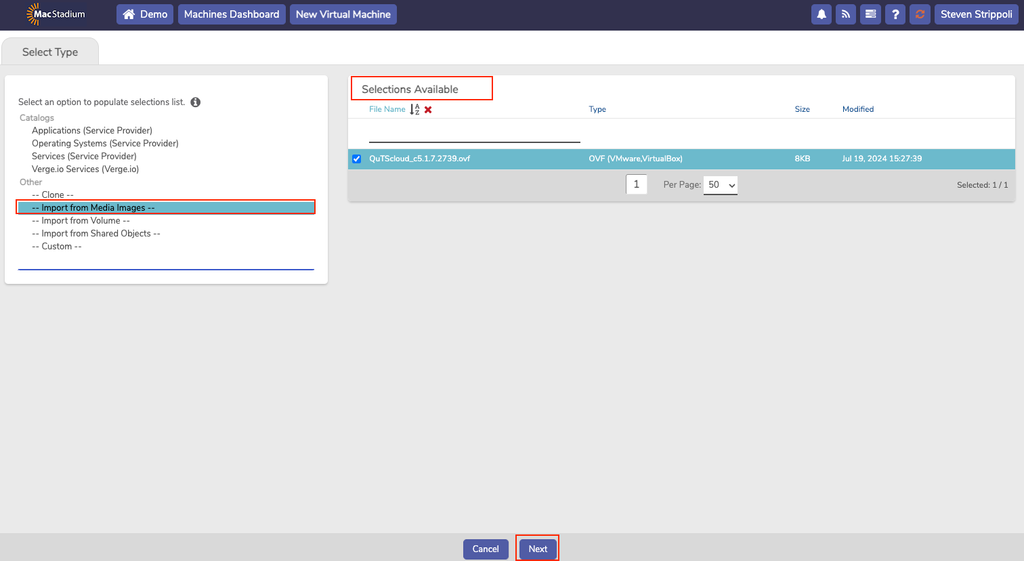
Select Type Tab
- Click Next.
- The VM Name defaults to the name of the configuration file unless a custom name was specified.
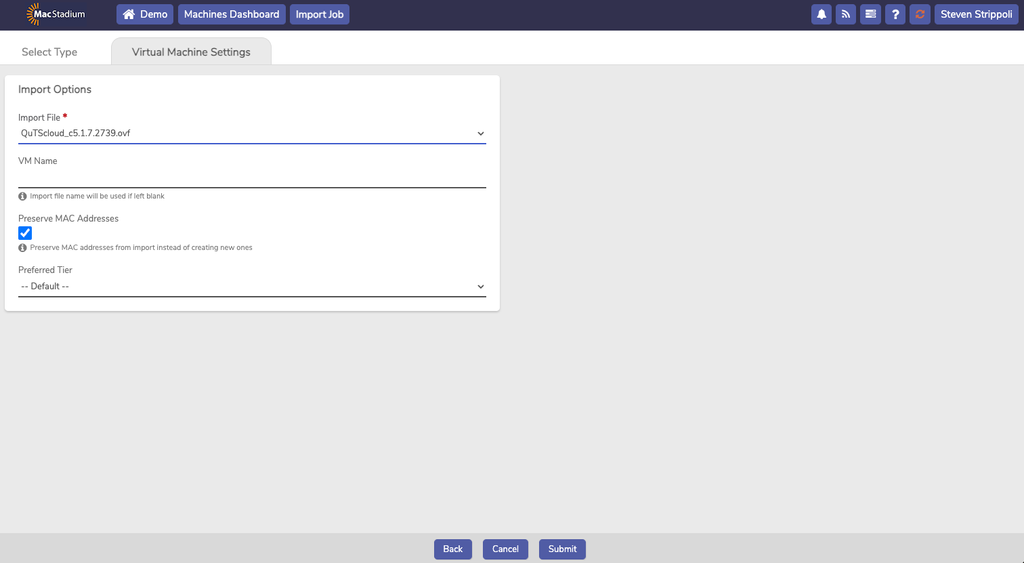
Import File
- By default, the Preserve MAC Address option is selected.
- Select the Preferred Tier, which specifies the storage tier for the VM's disks.
- Click Submit.
Cloning VMs
A new VM instance is launched as a copy of an existing VM. A clone is given different MAC address(es) than the original VM allowing the clone to run in the same network as the original VM, without causing an IP conflict.
- Navigate to Machines → Virtual Machines.
- Click New.
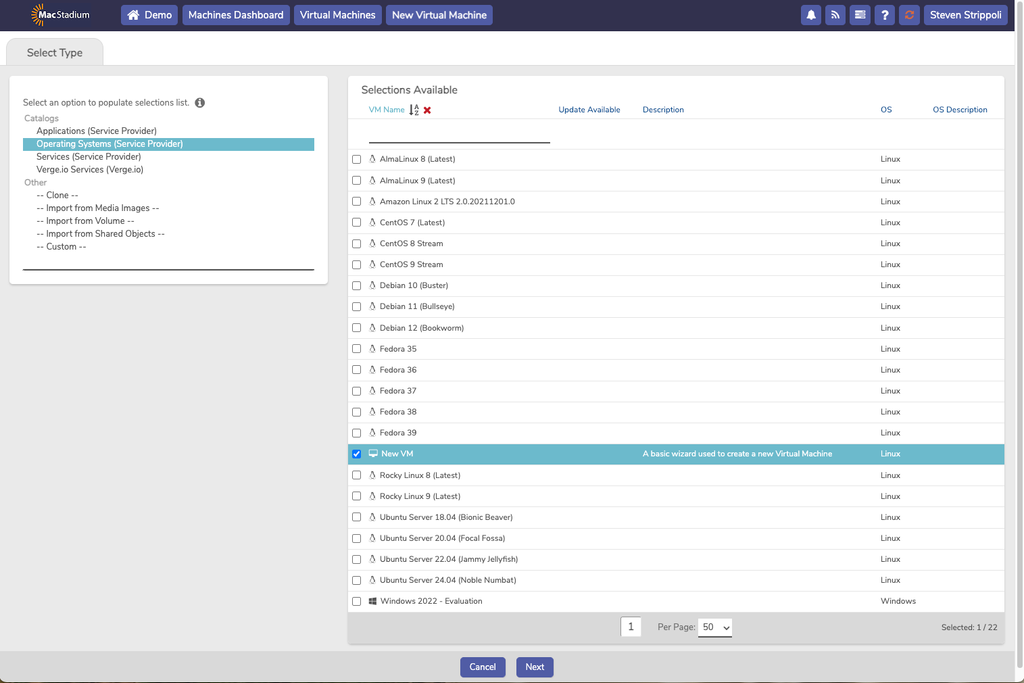
Select Type
- Select --Clone--. The Selection list on the right populates with a list of all existing VMs.
- Select the VM to clone from the Selections Available list (on the right),
- Click Next.
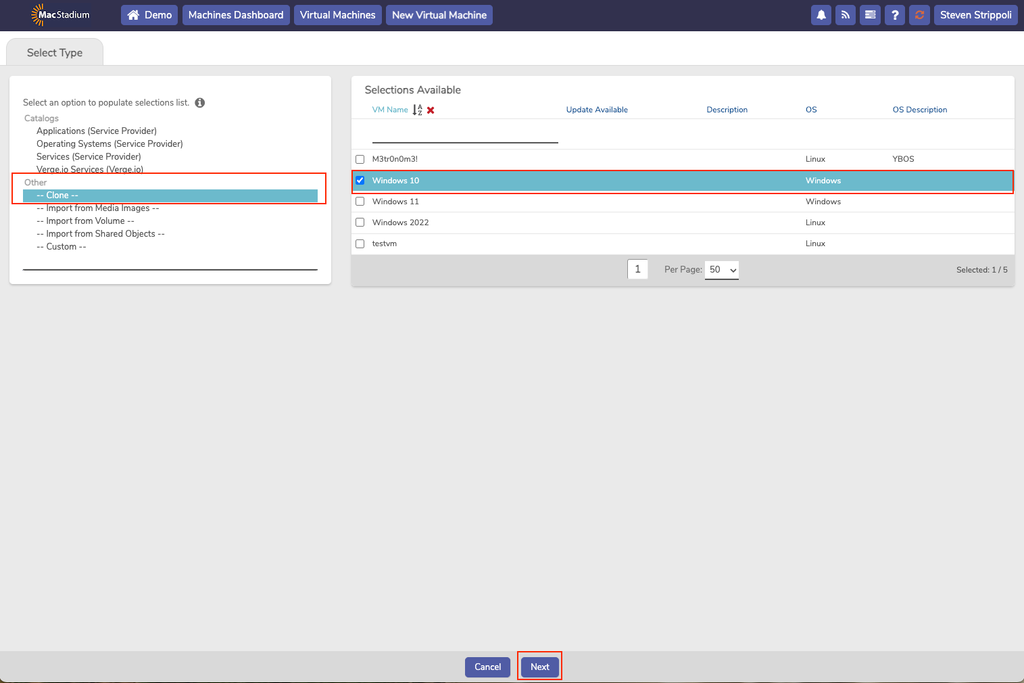
Clone
Note:
The VM Name defaults to the original VM Name + clone; however, the name can be changed as desired.
- By default, the new clone instance employs unique MAC addresses that are different from the source VM .
- Preserve MAC Addresses option can be enabled in order to copy MAC addresses from the original VM to the new clone instance; however, this option should be used with caution as NICs with duplicate addresses running on the same network will cause problems.
- Preserve Device UUIDs can be checked to create the clone with same UUIDs as the original. VMs running with the same UUIDs may cause problems. Use this option only if required.
- Quiesce File System provides for an application-consistent clone of a VM that is in a running state. (A Guest Agent must be installed and running on the VM.) When the option is selected: if the source VM is running the file system is put into a state suitable for backups (that is, notify VSS-aware applications, freeze filesystem. flush buffers, and so on.)
- Click Submit.
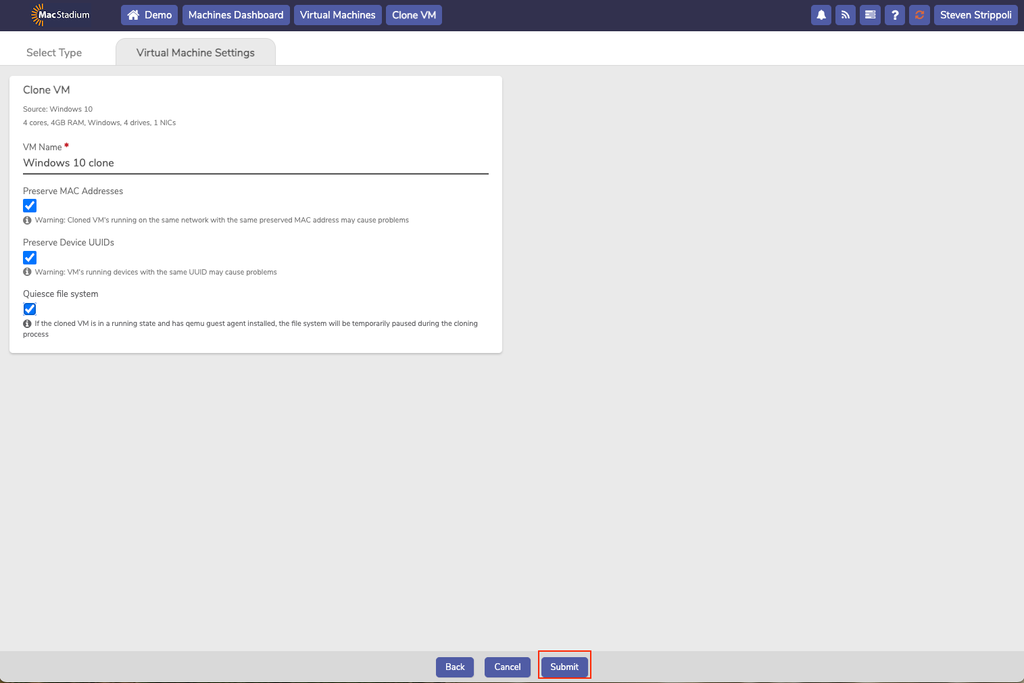
Clone VM Tab
Note:
A message appears indicating the VM was created successfully and stating drives and NICS can now be created for the VM.
- Click OK to see the Dashboard page for the VM.
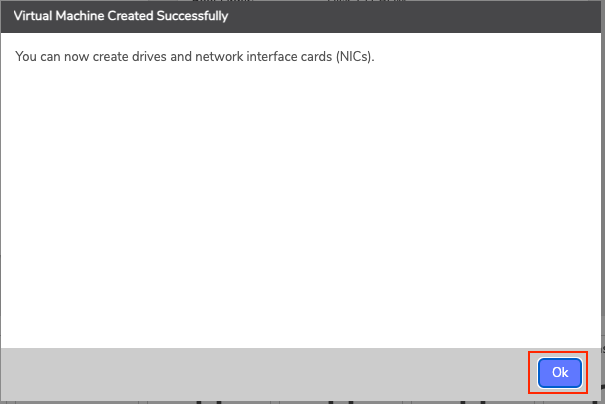
Confirmation Box
Note:
VM drives and NICs from the original VM automatically carry over to the cloned VM. Additional drives and NICs can be added to the VM as needed.
VM Resource Management
Managing VM resources, for example, redistributing RAMS and Cores, can make them work better.
RAM and Core Management
The amount of RAM allocated to a virtual machine is based on the workloads that the VM is running.
- Click Machine on the main page to view a list of machines in the Private Cloud.
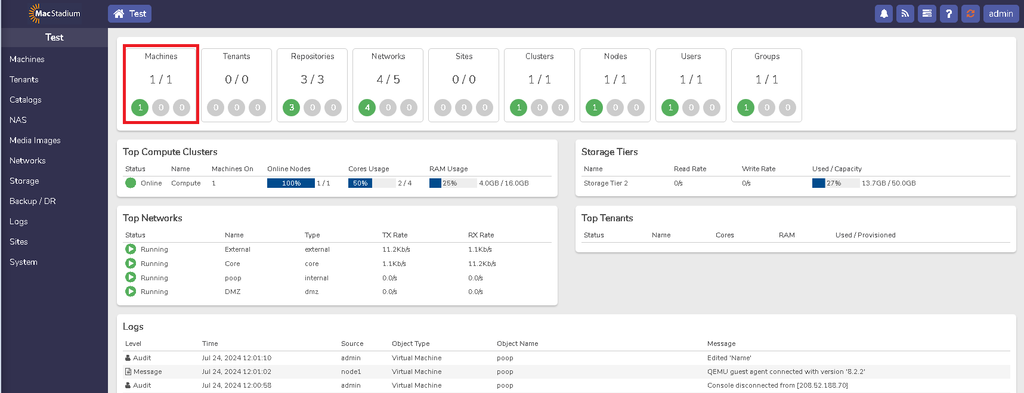
Machines
- Select a VM.
- To modify the CPU core and RAM allocation for the desired VM, click Edit.
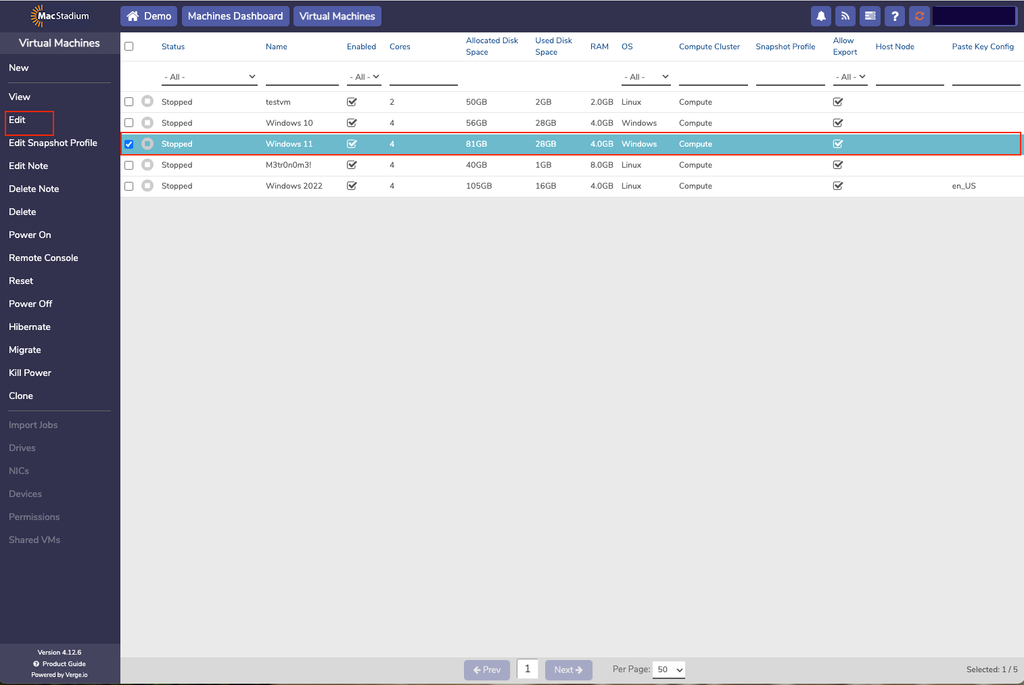
Edit
- Edit the provisioned amount of RAM and number of vCPU cores, then click Submit.
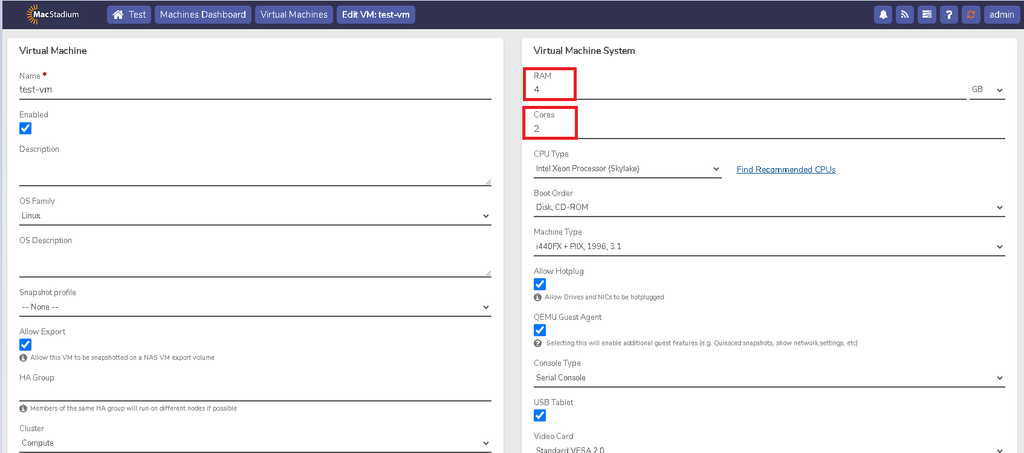
Virtual Machine
Notes:
- If the VM is off, then the change is immediate.
- If the VM is online, then a reboot is required for the change to take effect.
Drive Management
The amount of RAM allocated to a virtual machine is based on the workloads that the VM is running.
- To edit Drives, click Machines from the main page.
- Click Virtual Machines.
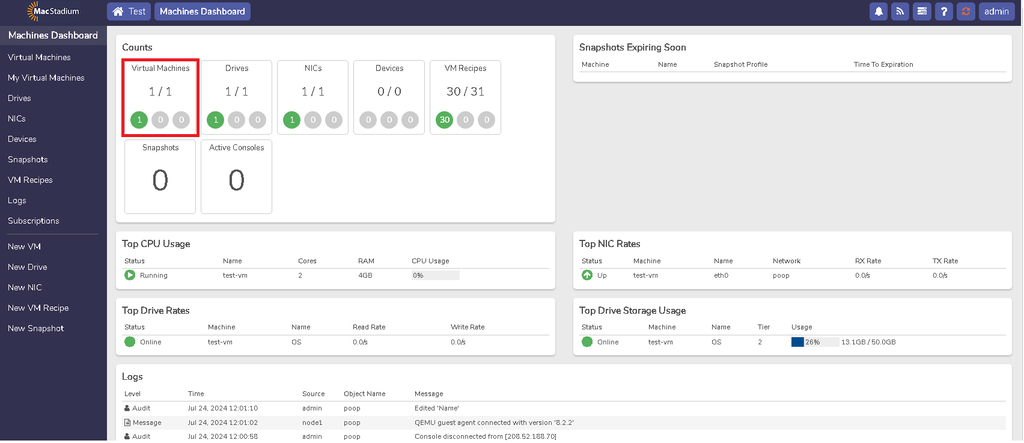
Virtual Machines
- Double-click the desired Virtual Machine.
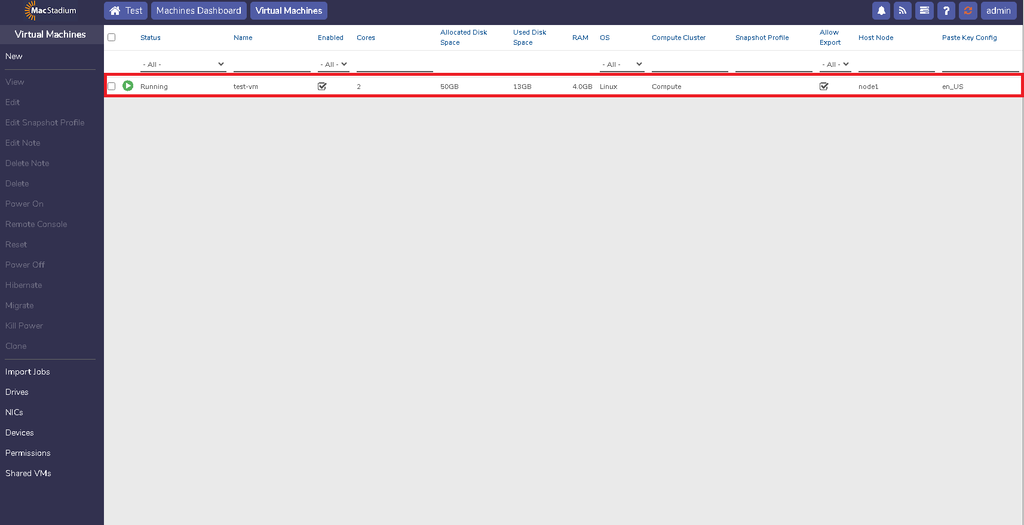
Running
- Click Drives.
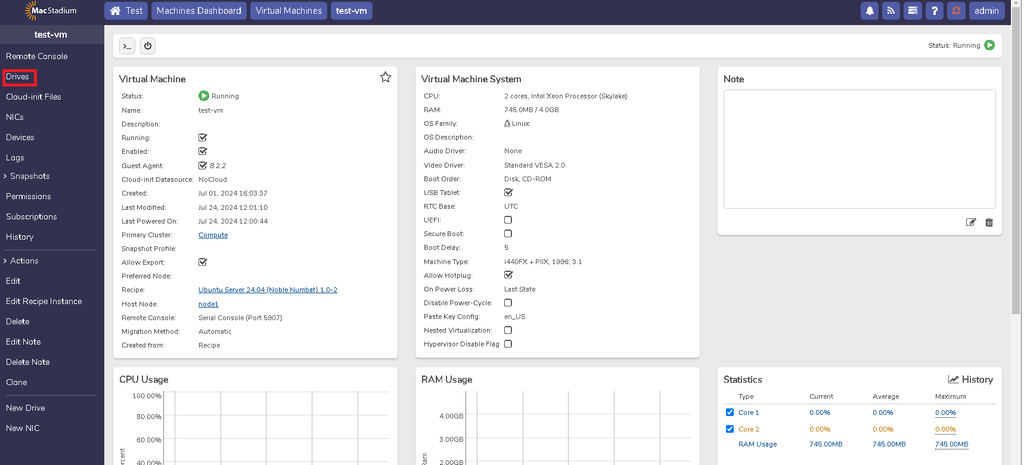
Drives
- Select the desired drive.
- Click Edit.
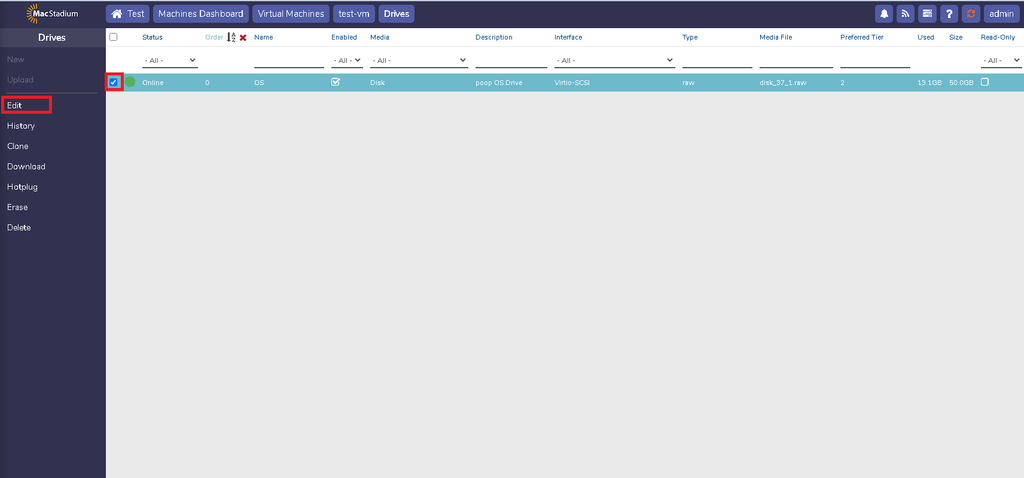
Edit
- Provide the desired value for Disk size.

Disk Space
Notes:
- Disk space can only be increased. It cannot be decreased.
- Many operating systems require the filesystem on the disk to be expanded to match the size of the expanded drive.
- Click Submit.
Updated 10 months ago
